
Transcriber’s note: Table of Contents added by Transcriber and placed into the Public Domain. Some maps will show more detail in larger windows or when stretched.
Marines in
World War II
Commemorative Series
By Colonel Joseph H. Alexander
U.S. Marine Corps (Ret)


by Colonel Joseph H. Alexander, USMC (Ret)
Daybreak on 29 May 1945 found the 1st Marine Division beginning its fifth consecutive week of frontal assault as part of the U.S. Tenth Army’s grinding offensive against the Japanese defenses centered on Shuri Castle in southern Okinawa. Operation Iceberg, the campaign to seize Okinawa, was now two months old—and badly bogged down. The exhilarating, fast-paced opening of the campaign had been replaced by week after week of costly, exhausting, attrition warfare against the Shuri complex.
The 1st Marine Division, hemmed in between two other divisions with precious little maneuver room, had advanced barely a thousand yards in the past 18 days—an average of 55 yards each bloody day. Their sector featured one bristling, honeycombed ridge line after another—sequentially Kakazu, Dakeshi, and Wana (with its murderous, reverse slope canyon). Just beyond lay the long shoulder of Shuri Ridge, the nerve center of the Japanese Thirty-second Army and the outpost of dozens of the enemy’s forward artillery observers who had made life so miserable for American assault forces all month long.
But on this rainy morning, this 29th of May, things seemed somehow different, quieter. After days of bitter fighting, American forces had finally overrun both outposts of the Shuri Line: Conical Hill on the east, captured by the 96th Infantry Division, and the Sugar Loaf complex in the west, seized by the 6th Marine Division. Shuri no longer seemed invincible.
Company A of the 1st Battalion, 5th Marines moved out warily, expecting the usual firestorm of Japanese artillery at any moment. There was none. The Marines reached the crest of Shuri Ridge with hardly a firefight. Astonished, the company commander looked westward along the ridge several hundred yards to the ruins of Shuri Castle, the medieval fortress of the ancient Ryukyuan kings. Everyone in the Tenth Army expected the Japanese to defend Shuri to the death—but the place seemed lightly held. Spiteful small arms fire appeared to come from nothing more than a rear guard. Field radios buzzed with this astounding news. Shuri Castle itself lay beyond division and corps boundaries, but it was there for the taking. The assault Marines asked permission to seize the prize.
Major General Pedro del Valle, commanding the 1st Marine Division, did not hesitate. By all rights the castle belonged to the neighboring 77th Infantry Division and del Valle knew his counterpart, Army Major General Andrew D. Bruce, would be angry if the Marines snatched the long-sought trophy before his soldiers could arrive. But this was an unprecedented opportunity to grab the Tenth Army’s main objective. Del Valle gave the go-ahead. With that, Company A, 1/5, swept west along the ridge against light opposition and took possession of the battered complex. Del Valle’s staff had to do some fancy footwork to keep peace with their Army neighbors. Only then did they learn that the 77th Division had scheduled a major bombardment of the castle that morning. Frantic radio calls averted the near-tragedy just in time. Results of the Marines’ preemptive action incensed General Bruce. Recalled del Valle: “I don’t think a single Army division commander would talk to me after that.”
Notwithstanding this interservice aggravation, the Americans had achieved much this morning. For two months the Shuri Heights had provided the Japanese with superb fields of observed fire that covered the port city of Naha and the entire five-mile neck of southern Okinawa. Even now, as the Marines of A/1/5 deployed into a hasty defensive line within the Castle’s rubble, they were oblivious to the fact that a Japanese rear guard still occupied portions of the mammoth underground headquarters complex directly under their muddy boondockers. They would be astounded to learn that the subterranean headquarters of the Thirty-second Army measured 1,287 feet long and as much as 160 feet deep—all of it dug by pick and shovel.
The Japanese had in fact stolen a march on the approaching Tenth Army. Most of their forces had retreated southwards during the incessant rains, and would soon occupy2 the third (and final) ring of their prepared, underground defenses, a series of fortified escarpments in the Kiyamu Peninsula.

Department of Defense Photo (USMC) 124370
A mass of rubble is all that is left of Shuri Castle, its walls, the moat below them, and Shuri City beyond, after the 5th Marines had captured the area. The battered trees are part of a forest growth which in more peaceful times had surrounded it.
Seizing Shuri Castle represented an undeniable milestone in the Okinawa campaign, but it was a hollow victory. Just as the flag-raising on Iwo Jima’s Mount Suribachi signified only the end of the beginning of that prolonged battle, the capture of Shuri did not end the fighting. The brutal slugfest on Okinawa still had another 24 days to run. And still the Plum Rains fell, and the horrors, and the dying, continued.
The three-month-long battle of Okinawa covered a 700-mile arc from Formosa to Kyushu and involved a million combatants—Americans, Japanese, British, and native Okinawans. With a magnitude that rivaled the Normandy invasion the previous June, the battle of Okinawa was the biggest and costliest single operation of the Pacific War. For each of its 82 days of combat, the battle would claim an average of 3,000 lives from the antagonists and the unfortunate non-combatants.
Imperial Japan by spring 1945 has been characterized as a wounded wild animal, enraged, cornered, and desperate. Japanese leaders knew fully well that Okinawa in U.S. hands would be transformed into a gigantic staging base—“the England of the Pacific”—for the ultimate invasion of the sacred homeland. They were willing to sacrifice everything to avoid the unspeakable disgrace of unconditional surrender and foreign occupation.
Okinawa would therefore present the U.S. Navy with its greatest operational challenge: protecting an enormous and vulnerable amphibious task force tethered to the beachhead against the ungodliest of furies, the Japanese kamikazes. Equally, Okinawa would test whether U.S. amphibious power projection had truly come of age—whether Americans in the Pacific Theater could plan and execute a massive assault against a large, heavily defended land-mass, integrate the tactical capabilities of all services, fend off every imaginable form of counterattack, and maintain operational momentum ashore. Nor would Operation Iceberg be conducted in a vacuum. Action preliminary to the invasion would kick-off at the same time that major campaigns in Iwo Jima and the Philippines were still being wrapped up, a reflection of the great expansion of American military power in the Pacific, yet a further strain on Allied resources.
But as expansive and dramatic as the Battle of Okinawa proved to be, both sides clearly saw the contest as a foretaste of even more desperate fighting to come with the inevitable invasion of the Japanese home islands. Okinawa’s proximity to Japan—well within medium bomber and fighter escort range—and its militarily useful ports, airfields, anchorages, and training areas—made the skinny island an imperative objective for the Americans, eclipsing their earlier plans for the seizure of Formosa for that purpose.
A well-armed Marine assault team, with a BAR and a flamethrower, moves out and heads for its objective across the rubble created by preliminary bombardment.
Department of Defense Photo (USMC) 116632
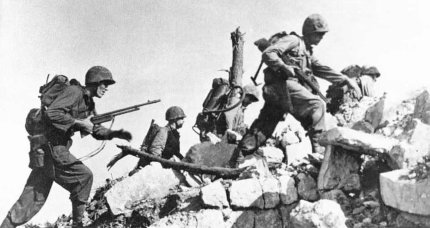
Okinawa, the largest of the Ryukyuan Islands, sits at the apex of a4 triangle almost equidistant to strategic areas. Kyushu is 350 miles to the north; Formosa 330 miles to the southwest; Shanghai 450 miles to the west. As so many Pacific battlefields, Okinawa had a peaceful heritage. Although officially one of the administrative prefectures of Japan, and Japanese territory since being forcibly seized in 1879, Okinawa prided itself on its distinctive differences, its long Chinese legacy and Malay influence, and a unique sense of community.
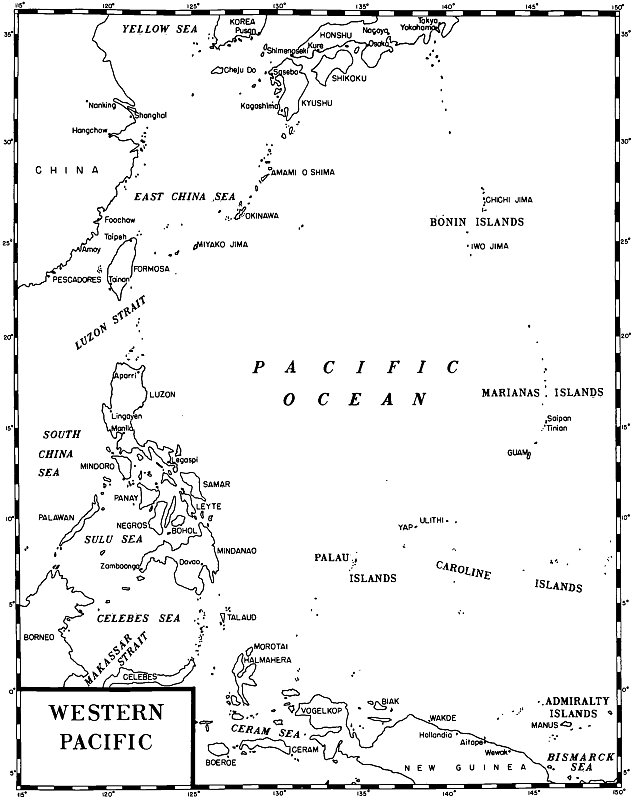
The Japanese Imperial General Headquarters (IGHQ) in Tokyo did little to fortify or garrison Okinawa in the opening years of the Pacific War. With the American seizure of Saipan in mid-1944, however, IGHQ began dispatching reinforcements and fortification materials to critical areas within the “Inner Strategic Zone,” including Iwo Jima, Peleliu, the Philippines, and Okinawa.
On Okinawa, IGHQ established a new field army, the Thirty-second Army, and endeavored to funnel trained components to it from elsewhere along Japan’s great armed perimeter in China, Manchuria, or the home islands. But American submarines exacted a deadly toll. On 29 June 1944, the USS Sturgeon torpedoed the transport Toyama Maru and sank her with the loss of 5,600 troops of the 44th Independent Mixed Brigade, bound for Okinawa. It would take the Japanese the balance of the year to find qualified replacements.
By October 1944 the U.S. Joint Chiefs of Staff had recognized the paramount strategic value of the Ryukyus and issued orders to Admiral Chester W. Nimitz, Commander-in-Chief, Pacific Fleet/Commander, Pacific Ocean Areas, to seize Okinawa immediately after the Iwo Jima campaign. The JCS directed Nimitz to “seize, occupy, and defend Okinawa”—then transform the captured island into an advance staging base for the invasion of Japan.
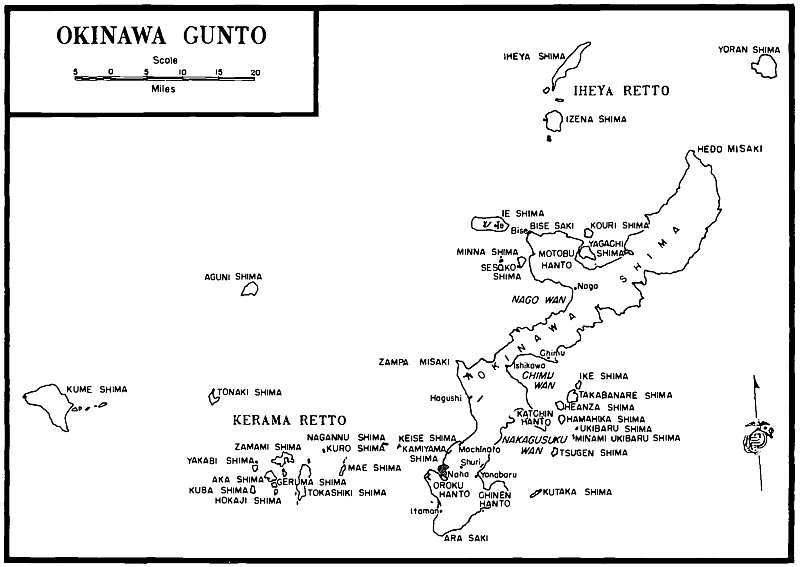
Nimitz turned once again to his most veteran commanders to execute the demanding mission. Admiral Raymond A. Spruance, victor of Midway, the Gilberts, Marshalls, Marianas, and the Battle of the Philippine Sea, would command the U.S. Fifth Fleet, arguably the most powerful armada of warships ever assembled. Vice Admiral Richmond Kelly Turner, gifted and irascible veteran of the Solomons and Central Pacific landings, would again command all amphibious forces under Spruance. But Turner’s military counterpart would no longer be the familiar old war-horse, Marine Lieutenant General Holland M. Smith. Iwo Jima had proven to be Smith’s last fight. Now the expeditionary forces had grown to the size of a field5 army with 182,000 assault troops. Army Lieutenant General Simon Bolivar Buckner, Jr., the son of a Confederate general who fought against U.S. Grant at Fort Donaldson in the American Civil War, would command the newly created U.S. Tenth Army.
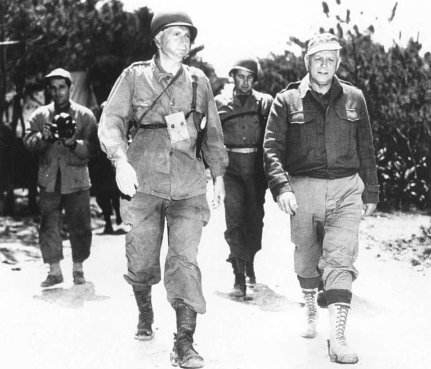
Department of Defense Photo (USMC) 128548
In early April, Tenth Army commander LtGen Simon B. Buckner, Jr., USA, left, and Marine MajGen Roy S. Geiger, Commanding General, III Amphibious Corps, met to discuss the progress of the campaign. Upon Buckner’s death near the end of the operation, Geiger was given command of the army and a third star.
General Buckner took pains to ensure that the composition of the Tenth Army staff reflected his command’s multiservice composition. Thirty-four Marine officers served on Buckner’s staff, for example, including Brigadier General Oliver P. Smith, USMC, as his Marine Deputy Chief of Staff. As Smith later remarked, “the Tenth Army became in effect a joint task force under CINCPOA.”
Six veteran divisions—four Army, two Marine—would comprise Buckner’s landing force, with a division from each service marked for reserve duty. Here was another indication of the growth of U.S. amphibious power in the Pacific. Earlier, the Americans had forcibly landed one infantry division at Guadalcanal, two each in the Gilberts, Marshalls, and Palaus, and three each at Saipan and Iwo. By spring 1945, Spruance and Buckner could count on eight experienced divisions, above and beyond those still committed at Iwo or Luzon.
Buckner’s Tenth Army had three major operational components. Army Major General John R. Hodge commanded the XXIV Corps, comprised of the 7th, 77th, and 96th Infantry Divisions, with the 27th Infantry Division in floating reserve, and the 81st Infantry Division in area reserve. Marine Major General Roy S. Geiger commanded the III Amphibious Corps (IIIAC), comprised of the 1st and 6th Marine Divisions, with the 2d Marine Division in floating reserve. Both corps had recent campaign experience, the XXIV in Leyte, the IIIAC at Guam and Peleliu. The third major component of Buckner’s command was the Tactical Air Force, Tenth Army, commanded by Marine Major General Francis P. Mulcahy, who also commanded the 2d Marine Aircraft Wing. His Fighter Command was headed by Marine Brigadier General William J. Wallace.
The Marine components staged for Iceberg in scattered locations. The 1st Marine Division, commanded by Major General Pedro A. del Valle, had returned from Peleliu to “pitiful Pavuvu” in the Russell Islands to prepare for the next campaign. The 1st Division had also been the first to deploy to the Pacific and had executed difficult amphibious campaigns at Guadalcanal, Cape Gloucester, and Peleliu. At least one-third of the troops were veterans of two of those battles; another third had experienced at least one. Tiny Pavuvu severely limited work-up training, but a large-scale exercise in nearby Guadalcanal enabled the division to integrate its newcomers and returning veterans. General del Valle, a consummate artillery officer, ensured that his troops conducted tank-infantry training under the protective umbrella of supporting howitzer fires.
The 6th Marine Division became the only division to be formed overseas in the war when Major General Lemuel C. Shepherd, Jr., activated the colors and assumed command in Guadalcanal in September 1944. The unit may have been new, but hardly a greenhorn could be found in its leadership ranks. Many former Mariner raiders with combat experience in the Solomons comprised the heart of the 4th Marines. The regiment had also landed at Emirau and Guam. The 22d Marines had combat experience at Eniwetok and Guam. And while the 29th Marines comprised a relatively new infantry regiment, its 1st Battalion had played a pivotal role in the Saipan campaign. General Shepherd used his time and the more expansive facilities on Guadalcanal to conduct progressive, work-up training, from platoon to regimental level. Looking ahead to Okinawa, Shepherd emphasized rapid troop deployments, large-scale operations, and combat in built-up areas.
6 The 2d Marine Division, commanded by Major General LeRoy P. Hunt, had returned to Saipan after completing the conquest of Tinian. There the division absorbed up to 8,000 replacements and endeavored to train for a frustratingly varied series of mission assignments as, in effect, a strategic reserve. The unit already possessed an invaluable lineage in the Pacific War—Guadalcanal, Tarawa, Saipan, and Tinian—and its mere presence in Ryukyus’ waters would constitute a formidable “amphibious force-in-being” which would distract the Japanese on Okinawa. Yet the division would pay a disproportionate price for its bridesmaid’s role in the coming campaign.
The Marine divisions preparing to assault Okinawa experienced yet another organizational change, the fourth of the war. Headquarters Marine8 Corps (HQMC), constantly reviewing the lessons learned in the war to date, had just completed a series of revisions to the tables of organization and equipment for the division and its components. Although the “G-Series” T/O would not become official until a month after the landing, the divisions had already complied with most of the changes. The overall size of each division increased from 17,465 to 19,176. This growth reflected the addition of an assault signal company, a rocket platoon (the “Buck Rogers Men”), a war dog platoon, and—significantly—a 55-man assault platoon in each regimental headquarters. Artillery, motor transport, and service units received slight increases. So did the machine gun platoons in each rifle company. The most timely weapons change occurred with the replacement of the 75mm “half-tracks” with the newly developed M-7 105mm self-propelled howitzer—four to each regiment. Purists in the artillery regiments tended to sniff at these weapons, deployed by the infantry not as massed howitzers but rather as direct-fire, open-sights “siege guns” against Okinawa’s thousands of fortified caves, but the riflemen soon swore by them.
Headquarters, U.S. Marine Corps, backed up these last-minute changes by providing the quantities of replacements required, so that each assault division actually landed at full tables of organization (T/O) strength, plus the equivalent of two replacement drafts each. Sometimes the skills required did not match the requirement, however. Some of the artillery regiments had to absorb a flood of radar technicians and antiaircraft artillery gunners from the old Defense Battalions at the last moment. But by and large, the manpower and equipment shortfalls which had beset many early operations had been overcome by the time of embarkation for the Okinawa campaign.
Surprisingly for this late in the war, operational intelligence proved9 less than satisfactory prior to the Okinawa landing. Where pre-assault combat intelligence had been superb in the earlier operations at Tarawa (the apogean neap tide notwithstanding) and Tinian, here at Okinawa, the landing force did not have accurate figures of the enemy’s numbers, weapons, and disposition, or intelligence of his abilities. Part of the problem lay in the fact that cloud cover over the island most of the time prevented accurate and complete photo-reconnaisance of the target area. In addition, the incredible digging skills of the defending garrison and the ingenuity of the Japanese commander conspired to disguise the island’s defenses.

OKINAWA SHIMA
Showing Principal Roads, Towns, and Villages
The island of Okinawa is 60 miles long, but only the lower third contained the significant military objectives of airfields, ports, and anchorages. When Lieutenant General Mitsuru Ushijima assumed command of the Thirty-second Army in August 1944, he quickly realized this and decided to concentrate his forces in the south. He also decided, regretfully, to refrain from contesting the likely American landings along the broad beaches at Hagushi on the southwest coast. Doing so would forfeit the prize airfields of Yontan and Kadena, but it would permit Ushijima to conserve his forces and fight the only kind of battle he thought had a chance for the Empire: a defense in depth, largely underground and thus protected from the overwhelming American superiority in supporting arms. This was the attrition/cave warfare of the more recent defenses at Biak, Peleliu, and Iwo Jima. Each had exacted a frightful cost on the American invaders. Ushijima sought to duplicate this philosophy in spades. He would go to ground, sting the Americans with major-caliber gunfire from his freshly excavated “fire-port” caves, bleed them badly, bog down their momentum—and in so doing provide the Imperial Army and Navy air arms the opportunity to destroy the Fifth Fleet by massed kamikaze attacks.
To achieve this strategy, Ushijima had upwards of 100,000 troops on the island, including a generous number of Okinawan conscripts, the Home Guard known as Boeitai. He also had a disproportionate number of artillery and heavy weapon units in his command. The Americans in the Pacific would not encounter a more formidable concentration of 150mm howitzers, 120mm mortars, 320mm mortars, and 47mm antitank guns. Finally, Ushijima also had time. The American strategic decisions to assault the Philippines, Peleliu, and Iwo Jima before Okinawa gave the Japanese garrison on Okinawa seven months to develop its defenses around the Shuri epicenter. Americans had already seen what the Japanese could do in terms of fortifying a position within an incredibly short time. At Okinawa, they achieved a masterpiece. Working entirely with hand tools—there was not a single bulldozer on the island—the garrison dug miles of underground fighting positions, literally honeycombing southern Okinawa’s ridges and draws, and stocked each successive position with reserves of ammunition, food, water, and medical supplies. The Americans expected a ferocious defense of the Hagushi beaches and the airfields just beyond, followed by a general counterattack—then the battle would be over except for mop-up patrolling. They could not have been more misinformed.
10 The U.S. plan of attack called for advance seizure of the Kerama Retto Islands off the southwest coast, several days of preliminary air and naval gunfire bombardment, a massive four-division assault over the Hagushi Beaches (the Marines of IIIAC on the north, the soldiers of XXIV Corps on the south). Meanwhile, the 2d Marine Division with a separate naval task unit would endeavor to duplicate opposite the Minatoga Beaches on Okinawa’s southeast coast its successful amphibious feint off Tinian. Love-Day (selected from the existing phonetic alphabet in order to avoid planning confusion with “D-Day” being planned for Iwo Jima) would occur on 1 April 1945. Hardly a man failed to comment on the obvious irony: it was April Fool’s Day and Easter Sunday—which would prevail?
The U.S. Fifth Fleet constituted an awesome sight as it sortied from Ulithi Atoll and a dozen other ports and anchorages to steam towards the Ryukyus. Those Marines who had returned to the Pacific from the original amphibious offensive at Guadalcanal some 31 months earlier marveled at the profusion of assault ships and landing craft. The new vessels covered the horizon, a mind-boggling sight.
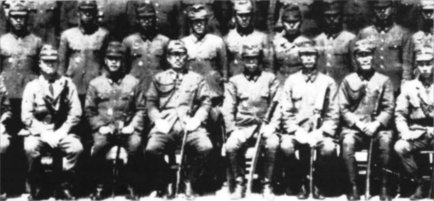
On 26 March, the 77th Infantry Division kicked off the campaign by its skillful seizure of the Kerama Retto, a move which surprised the Japanese and produced great operational dividends. Admiral Turner now had a series of sheltered anchorages to repair ships likely to be damaged by Japanese air attacks—and already kamikazes were exacting a toll. The soldiers also discovered the main cache of Japanese suicide boats, nearly 300 power boats equipped with high-explosive rams intended to sink the thin-skinned troop transports in their anchorages off the west coast of Okinawa. The Fleet Marine Force, Pacific, Force Reconnaissance Battalion, commanded by Major James L. Jones, USMC, preceded each Army landing with stealthy scouting missions the preceding night. Jones’ Marines also scouted the barren sand spits of Keise Shima and found them undefended. With that welcome news, the Army landed a battery of 155mm “Long Toms” on the small islets and soon added their considerable firepower to the naval bombardment of the southwest coast of Okinawa.
Meanwhile, Turner’s minesweepers had their hands full clearing approach lanes to the Hagushi Beaches. Navy Underwater Demolition Teams, augmented by Marines, blew up hundreds of man-made obstacles in the shallows. And in a full week of preliminary bombardment, the fire support ships delivered more than 25,000 rounds of five-inch shells or larger. The shelling produced more spectacle than destruction, however, because the invaders still believed General Ushijima’s forces would be arrayed around the beaches and airfields. A bombardment of that scale and duration would have saved many lives at Iwo Jima; at Okinawa this precious ordnance produced few tangible results.
A Japanese soldier observing the huge armada bearing down on Okinawa wrote in his diary, “it’s like a frog meeting a snake and waiting for the snake to eat him.” Tensions ran high among the U.S. transports as well. The 60mm mortar section of Company K, 3d Battalion, 5th Marines, learned that casualty rates on L-Day could reach 80–85 percent. “This was not conducive to a good night’s sleep,” remarked Private First Class Eugene B. Sledge, a veteran of the Peleliu landing. On board another transport, combat correspondent Ernie Pyle sat down to a last hot meal with the enlisted Marines: “‘Fattening us up for the kill,’ the boys say,” he reported. On board a nearby LST, a platoon commander rehearsed his troops in the use of home-made scaling ladders to surmount a concrete wall just beyond the beaches. “Remember, don’t stop—get off that wall, or somebody’s gonna get hurt.”
Operation Iceberg got off to a roaring start. The few Japanese still in the vicinity of the main assault at first light on L-Day, 1 April 1945, could immediately sense the wisdom of General Ushijima in conceding the landing to the Americans. The enormous armada, assembled from ports all over the Pacific Ocean, had concentrated on schedule off Okinawa’s southwest coast and stood coiled to project its 182,000-man landing force over the beach. This would be the ultimate forcible entry, the epitome of all the amphibious lessons learned so painstakingly from the crude beginnings at Guadalcanal and North Africa.
Admiral Turner made his final review of weather conditions in the amphibious objective area. As at Iwo Jima, the amphibians would be blessed with good weather on the critical first day of the landing. Skies would be cloudy to clear, winds moderate east to northeast, surf moderate, temperature 75 degrees. At 0406 Turner announced “Land the Landing Force,” the familiar phrase which marked the sequential countdown to the first assault waves hitting the beaches at H-Hour. Combat troops already manning the rails of their transports then witnessed an unforgettable display of naval power—the sustained bombardment by shells and rockets from hundreds of ships, alternating with formations of attack aircraft streaking low over the beaches, bombing and strafing at will. Enemy return fire seemed scattered and ineffectual, even against12 such a mass of lucrative targets assembled offshore. Turner confirmed H-Hour at 0830.
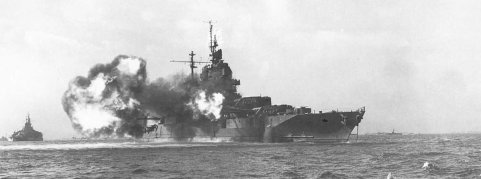
Department of Defense Photo (USMC) 116412
Taking part in the prelanding bombardment of Okinawa was the Idaho (BB 42), blasting away at the island with her 14-inch guns at preselected targets. As the troops landed, naval gunfire ships let loose with rolling barrages which cleared the way.
Now came the turn of the 2d Marine Division and the ships of the Diversionary Force to decoy the Japanese with a feint landing on the opposite coast. The ersatz amphibious force steamed into position, launched amphibian tractors and Higgins boats, loaded them conspicuously with combat-equipped Marines, then dispatched them towards Minatoga Beach in seven waves. Paying careful attention to the clock, the fourth wave commander crossed the line of departure exactly at 0830, the time of the real H-Hour on the west coast. The LVTs and boats then turned sharply away and returned to the transports, mission accomplished.
There is little doubt that the diversionary landing (and a repeat performance the following day) achieved its purpose. In fact, General Ushijima retained major, front-line infantry and artillery units in the Minatoga area for several weeks thereafter as a contingency against a secondary landing he fully anticipated. The garrison also reported to IGHQ on L-Day morning that “enemy landing attempt on east coast completely foiled with heavy losses to enemy.”
But the successful deception came at considerable cost. Japanese kamikazes, convinced that this was the main landing, struck the small force that same morning, seriously damaging the troopship Hinsdale and LST 844. The 3d Battalion, 2d Marines, and the 2d Amphibian Tractor Battalion suffered nearly 50 casualties; the two ships lost an equal number of sailors. Ironically, the division expected to have the least damage or casualties in the L-Day battle lost more men than any other division in the Tenth Army that day. Complained division Operations Officer Lieutenant Colonel Samuel G. Taxis: “We had asked for air cover for the feint but were told the threat would be ‘incidental.’”
A flotilla of LSM-Rs delivers final suppressive fires before assault waves hit the beach. Upon impact, they churned up the earth and caused considerable damage.
Photo by Capt Edward Steichen, USNR, in Marine Corps Historical Center
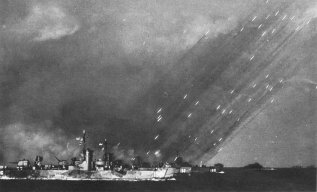
On the southwest approaches, the main body experienced no such interference. An extensive coral reef provided an offshore barrier to the Hagushi beaches, but by 1945 reefs no longer posed a problem to the landing force. Unlike Tarawa, where the reef dominated the tactical development of the battle, General Buckner at Okinawa had more than 1,400 LVTs to transport his assault echelons from ship to shore without13 hesitation. These long lines of LVTs now extended nearly eight miles as they churned across the line of departure on the heels of 360 armored LVT-As, whose turret-mounted, snub-nosed 75mm howitzers blasted away at the beach as they advanced the final 4,000 yards. Behind the LVTs came nearly 700 DUKWs, amphibious trucks, bearing the first of the direct support artillery battalions. The horizon behind the DUKWs seemed filled with lines of landing boats. These would pause at the reef to marry with outward bound LVTs. Soldiers and Marines alike had rehearsed transfer line operations exhaustively. There would be no break in the assault’s momentum this day.
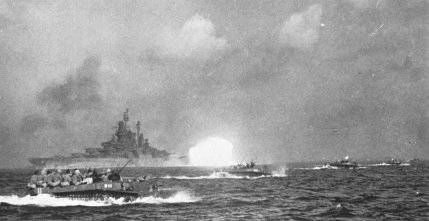
Photo by Capt Edward Steichen, USNR, in Marine Corps Historical Center
Amphibious mastery at work: assault Marines in amphibian tractors (LVTs) churn towards the beach on L-Day beneath the protective heavy fire of a battleship.
The mouth of the Bishi Gawa (River) marked the boundary between the XXIV Corps and IIIAC along the Hagushi beaches. The Marines’ tactical plan called for the two divisions to land abreast, the 1st on the right, the 6th on the left. Each division in turn landed with two regiments abreast. The assault regiments, from north to south, were the 22d, 4th, 7th, and 5th Marines. Reflecting years of practice, the first assault wave touched down close to 0830, the designated H-Hour. The Marines stormed out of their LVTs, swarmed over the berms and seawalls, and entered the great unknown. The forcible invasion of Okinawa had begun. Within the first hour the Tenth Army had put 16,000 combat troops ashore.

LANDING PLAN—1 APRIL 1945
HAGUSHI BEACHES
The assault troops experienced a universal shock during the ship-to-shore movement. In spite of the dire intelligence predictions and their own combat experience, the troops found the landing to be a cakewalk—virtually unopposed. Private First Class Gene Sledge’s mortar section went in singing “Little Brown Jug” at the top of its lungs. Corporal James L. Day, a rifle squad leader attached to Company F, 2d Battalion, 22d Marines, who had landed at Eniwetok and Guam earlier, couldn’t believe his good luck: “I didn’t hear a single shot14 all morning—it was unbelievable!” Most veterans expected an eruption of enemy fire any moment. Later in the day General del Valle’s LVT became stuck in a pothole enroute to the beach, the vehicle becoming a very lucrative, immobile target. “It was the worst 20 minutes I ever spent in my life,” he said.
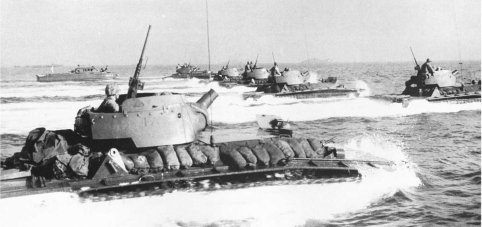
Department of Defense Photo (USMC) 116103
Armored amtracs of Company A, 1st Armored Amphibious Battalion, carry the assault wave of the 4th Marines, 6th Marine Division, onto Red Beach. The LVTs mount 75mm howitzers and .50-caliber machine guns, and were used effectively later in the campaign when the Thirty-second Army attempted amphibious landings on Tenth Army flanks in April.
The morning continued to offer pleasant surprises to the invaders. They found no mines along the beaches, discovered the main bridge over the Bishi River still intact and—wonder of wonders—both airfields relatively undefended. The 6th Marine Division seized Yontan Airfield by 1300; the 7th Infantry Division had no problems securing nearby Kadena.
The rapid clearance of the immediate beaches by the assault units left plenty of room for follow-on forces, and the division commanders did not hesitate to accelerate the landing of tanks, artillery battalions, and reserves. The mammoth build-up proceeded with only a few glitches. Four artillery pieces went down when their DUKWs foundered along the reef. Several Sherman tanks grounded on the reef. And the 3d Battalion, 1st Marines, reached the transfer line by 1800 but had to spend an uncomfortable night in its boats when sufficient LVTs could not be mustered at that hour for the final leg. These were minor inconveniences. Incredibly, by day’s end, the Tenth Army had 60,000 troops ashore, occupying an expanded beachhead eight miles long and two miles deep. This was the real measure of effectiveness of the Fifth Fleet’s proven amphibious proficiency.
The huge landing was not entirely bloodless. Snipers wounded Major John H. Gustafson, commanding the 3d Battalion, 5th Marines, late in the afternoon. Other men went down to enemy mortar and machine gun fire. But the losses of the entire Tenth Army, including the hard-luck 2d Marine Division, amounted to 28 killed, 104 wounded, and 27 missing on L-Day. This represented barely 10 percent of the casualties sustained by the V Amphibious Corps the first day on Iwo Jima.
Assault troops of the 1st Battalion, 7th Marines, clamber over a seawall after landing on Blue Beach 2 on 1 April 1945, against no opposition at the beachhead.
Department of Defense Photo (USMC) 117020

Nor did the momentum of the15 assault slow appreciably after the Tenth Army broke out of the beachhead. The 7th Infantry Division reached the East Coast on the second day. On the third day, the 1st Marine Division seized the Katchin Peninsula, effectively cutting the island in two. By that date, IIIAC elements had reached objectives thought originally to require 11 days in the taking. Lieutenant Colonel Victor H. Krulak, operations officer for the 6th Marine Division, recalls General Shepherd telling him, “Go ahead! Plow ahead as fast as you can. We’ve got these fellows on the run.” “Well, hell,” said Krulak, “we didn’t have them on the run. They weren’t there.”
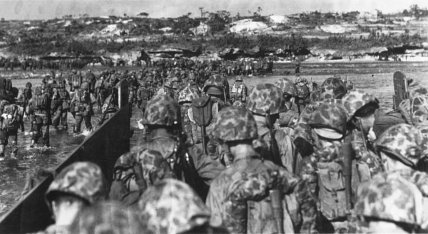
Department of Defense Photo (USMC) 116368
Other Marines were boated to the beachhead in LCVPs. Debarking from the Higgins boats, they waded through the quiet surf over the coral reef to reach shore.
As the 6th Marine Division swung north and the 1st Marine Division moved out to the west and northwest, their immediate problems stemmed not from the Japanese but from a sluggish supply system, still being processed over the beach. The reef-side transfer line worked well for troops but poorly for cargo. Navy beachmasters labored to construct an elaborate causeway to the reef, but in the meantime, the 1st Marine Division demonstrated some of its amphibious logistics know-how learned “on-the-job” at Peleliu. It mounted swinging cranes on powered causeways and secured the craft to the seaward side of the reef. Boats would pull alongside in deep water; the crane would lift nets filled with combat cargo from the boats into the open hatches of a DUKW or LVT waiting on the shoreward side for the final run to the beach. This worked so well that the division had to divide its assets among the other divisions within the Tenth Army.
Marines of the 6th Division have a peaceful “walk in the sun,” as they head north down the hillside approaching the town of Ishikawa on L-plus 3. Their idyllic traipse will end soon as they near Mount Yae Take and well-defended enemy positions.
Department of Defense Photo (USMC) 116523

Beach congestion also slowed the process. Both Marine divisions resorted to using their replacement drafts as shore party teams. Their inexperience in this vital work, combined16 with the constant call for groups as replacements, caused problems of traffic control, establishment of functional supply dumps, and pilferage. This was nothing new; other divisions in earlier operations had encountered the same circumstances. The rapidly advancing assault divisions had a critical need for motor transport and bulk fuel, but these proved slow to land and distribute. Okinawa’s rudimentary road network further compounded the problem. Colonel Edward W. Snedeker, commanding the 7th Marines, summarized the situation after the landing in this candid report: “The movement from the west coast landing beaches of Okinawa across the island was most difficult because of the rugged terrain crossed. It was physically exhausting for personnel who had been on transports a long time. It also presented initially an impossible supply problem in the Seventh’s zone of action because of the lack of roads.”

Department of Defense Photo (USMC) 118304
As invasion forces fanned out on Okinawa, the beaches were scenes of organized disorder as shore parties unloaded the beans and bullets needed by the assault troops. They also began unloading materiel which would be needed later in the campaign.
General Mulcahy did not hesitate to move the command post of the Tactical Air Force ashore as early as L plus 1. Operating from crude quarters between Yontan and Kadena, Mulcahy kept a close eye on the progress the SeaBees and Marine and Army engineers were making on repairing both captured airfields. The first American aircraft, a Marine observation plane, landed on 2 April. Two days later the fields were ready to accept fighters. By the eighth day, Mulcahy could accommodate medium bombers and announced to the Fleet his assumption of control of all aircraft ashore. By then his fighter arm, the Air Defense Command, had been established ashore nearby under the leadership of Marine Brigadier General William J. Wallace. With that, the graceful F4U Corsairs of Colonel John C. Munn’s Marine Aircraft Group (MAG) 31 and Colonel Ward E. Dickey’s MAG-33 began flying in from their escort carriers. Wallace immediately tasked them to fly combat air patrols (CAP) over the fleet, already seriously embattled by massed kamikaze attacks. Ironically, most of the Marine fighter pilots’ initial missions consisted of CAP assignments, while the Navy squadrons on board the escort carriers picked up the close air support jobs. Dawn of each new day would provide the spectacle of Marine Corsairs taking off from land to fly CAP over the far-flung Fifth Fleet, passing Navy Hellcats from the fleet coming in take station in support of the Marines fighting on the ground. Other air units poured into the two airfields as well: air warning squadrons, night fighters, torpedo bombers, and an Army Air Forces fighter wing. While neither Yontan nor Kadena were exactly safe havens—each received nightly artillery shelling and long-range bombing for the first full month ashore—the two airfields remained in operation around the clock, an invaluable asset to both Admiral Spruance and General Buckner.
While the 1st Marine Division continued to hunt down small bands of enemy guerrillas and infiltrators throughout the center of the island, General Geiger unleased the 6th Marine Division to sweep north. These were heady days for General Shepherd’s troops: riflemen clustered topside on tanks and self-propelled guns, streaming northward against a fleeing foe. Not since Tinian had Marines enjoyed such exhilarating mobility. By 7 April the division had seized Nago, the largest town in northern Okinawa, and the U.S. Navy obligingly swept for mines and employed underwater demolition teams (UDT) to breach obstacles in order to open the port for direct, seaborne delivery of critical supplies to the Marines. Corporal Day marveled at the rapidity of their advance so far. “Hell, here we were in Nago. It was not tough at all. Up to that time [our squad] had not lost a man.” The 22d Marines continued north through broken country, reaching Hedo Misaki at the far end of the island on L plus 12, having covered 55 miles from the Hagushi landing beaches.
For the remainder of the 6th Marine Division, the honeymoon was about to end. Just northwest of Nago17 the great bulbous nose of Motobu Peninsula juts out into the East China Sea. There, in a six-square-mile area around 1,200-foot Mount Yae Take, Colonel Takesiko Udo and his Kunigami Detachment ended their delaying tactics and assumed prepared defensive positions. Udo’s force consisted of two rifle battalions, a regimental gun company and an antitank company from the 44th Independent Mixed Brigade, in all about two thousand seasoned troops.

Department of Defense Photo (USMC) 117054
Grinning troops of the 29th Marines hitch a ride on board an M-7 self-propelled 105mm howitzer heading for Chuta in the drive towards Motobu Peninsula.
Yae Take proved to be a defender’s dream, broken into steep ravines and tangled with dense vegetation. The Japanese sowed the approaches with mines and mounted 20mm dual-purpose machine-cannons and heavier weapons deep within caves. As Colonel Krulak recalled: “They were just there—they weren’t going anywhere—they were going to fight to the death. They had a lot of naval guns that had come off disabled ships, and they dug them way back in holes where their arc of fire was not more than 10 or 12 degrees.” One of the artillery battalions of the 15th Marines had the misfortune to lay their guns directly within the narrow arc of a hidden 150mm cannon. “They lost two howitzers before you could spell cat,” said Krulak.
The battle of Yae Take became the 6th Marine Division’s first real fight, five days of difficult and deadly combat against an exceptionally determined enemy. Both the 4th and 29th Marines earned their spurs here, developing teamwork and tactics that would put them in good stead during the long campaign ahead.

APRIL 20
JAPANESE RESISTANCE
ON MOTOBU PEN. ENDS
Part of General Shepherd’s success in this battle stemmed from his desire to provide proven leaders in command of his troops. On the 15th, Shepherd relieved Colonel Victor F. Bleasdale, a well-decorated World War I Marine, to install Guadalcanal veteran Colonel William J. Whaling as commanding officer of the 29th Marines. When Japanese gunners killed Major Bernard W. Green, commanding the 1st Battalion, 4th Marines, Colonel Shapley assigned his own executive officer, Lieutenant Colonel Fred D. Beans, a former Marine raider, as his replacement. The savage fighting continued, with three battalions attacking from the west, two from the east—protected against friendly fire by the steep pinnacle between them. Logistic support to the fighting became so critical that every18 man, from private to general, who ascended the mountain to the front lines carried either a five-gallon water can or a case of ammo. And all hands coming down the mountain had to help bear stretchers of wounded Marines. On 15 April, one company of the 2d Battalion, 4th Marines, suffered 65 casualties, including three consecutive company commanders. On 16 April, two companies of the 1st Battalion, 4th Marines, seized the topographic crest. On the following day, the 29th Marines received exceptional fire support from the 14-inch guns of the old battleship Tennessee and low-level, in-your-pocket bombing from the Corsairs of Marine Fighter Squadron 322.
Colonel Udo and his Kunigami Detachment died to the man at Yae Take. On 20 April General Shepherd declared the Motobu Peninsula secured. His division had earned a valuable victory, but the cost had not been cheap. The 6th Marine Division suffered the loss of 207 killed and 757 wounded in the battle. The division’s overall performance impressed General Oliver P. Smith, who recorded in his journal:
The campaign in the north should dispel the belief held by some that Marines are beach-bound and are not capable of rapid movement. Troops moved rapidly over rugged terrain, repaired roads and blown bridges, successively opened new unloading points, and reached the northern tip of the island, some 55 miles from the original landing beaches, in 14 days. This was followed by a mountain campaign of 7 days duration to clear the Motobu Peninsula.
During the battle for Motobu Peninsula, the 77th Infantry Division once again displayed its amphibious prowess by landing on the island of Ie Shima to seize its airfields. On 16 April, Major Jones’ force reconnaissance Marines again helped pave the way by seizing Minna Shima, a tiny islet about 6,000 yards off shore from Ie Shima. Here the soldiers positioned a 105mm battery to further support operations ashore. The 77th needed plenty of fire support. Nearly 5,000 Japanese defended the island. The soldiers overwhelmed them in six days of very hard fighting at a cost of 1,100 casualties. One of these was the popular war correspondent Ernie Pyle, who had landed with the Marines on L-Day. A Japanese Nambu gunner on Ie Shima shot Pyle in the head, killing him instantly. Soldiers and Marines alike grieved over Pyle’s death, just as they had six days earlier with the news of President Franklin D. Roosevelt’s passing.
The 1st Marine Division fought a different campaign in April than their sister division to the north. Their days were filled with processing refugees and their nights with patrols and ambushes. Guerrillas and snipers exacted a small but steady toll. The 7th Marines became engaged in a hot firefight near Hizaonna, but most of the action remained small-unit and nocturnal. The “Old Breed” Marines welcomed the cycle of low intensity. After so many months in the tropics, they found Okinawa refreshingly cool and pastoral. The Marines grew concerned about the welfare of the thousands of Okinawan refugees who straggled northwards from the heavy fighting. As Private First Class Eugene Sledge observed, “The most pitiful things about the Okinawan civilians were that they were totally bewildered by the shock of our invasion, and they were scared to death of us. Countless times they passed us on the way to the rear with fear, dismay, and confusion on their faces.”
Uncovered on Motobu Peninsula, hidden in a cave, was this Japanese 150mm gun waiting to be used against 6th Marine Division troops advancing northwards.
Department of Defense Photo (USMC) 122207
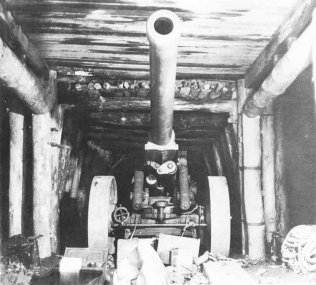
Sledge and his companions in the 5th Marines could tell by the sound of intense artillery fire to the south that the XXIV Corps had collided with General Ushijima’s outer defenses. Within the first week the soldiers of the 7th and 96th Divisions19 had answered the riddle of “where are the Japs?” By the second week, both General Hodge and General Buckner were painfully aware of Ushijima’s intentions and the range and depth of his defensive positions. In addition to their multitude of caves, minefields, and reverse-slope emplacements, the Japanese in the Shuri complex featured the greatest number of large-caliber weapons the Americans had ever faced in the Pacific. All major positions enjoyed mutually supporting fires from adjacent and interior hills and ridge-lines, themselves honeycombed with caves and fighting holes. Maintaining rigid adherence to these intricate networks of mutually supporting positions required iron discipline on the part of the Japanese troops. To the extent this discipline prevailed, the Americans found themselves entering killing zones of savage lethality.
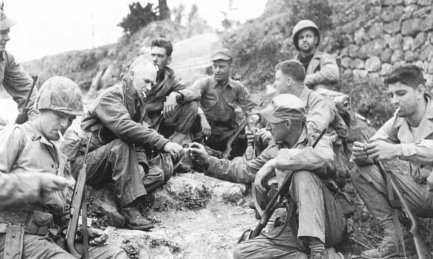
Department of Defense Photo (USMC) 116840
Shortly after the main landings on Okinawa, famed war correspondent Ernie Pyle, a Scripps-Howard columnist who had been in the thick of the war in the Italian campaign, shares a smoke with a Marine patrol. Later in Operation Iceberg he was killed by machine gun fire on Ie Shima, a nearby island fortress.
In typical fighting along this front, the Japanese would contain and isolate an American penetration (Army or Marine) by grazing fire from supporting positions, then smother the exposed troops on top of the initial objective with a rain of preregistered heavy mortar shells until fresh Japanese troops could swarm out of their reverse-slope tunnels in a counterattack. Often the Japanese shot down more Americans during their extraction from some fire-swept hilltop than they did in the initial advance. These early U.S. assaults set the pattern to be encountered for the duration of the campaign in the south.
General Buckner quickly committed the 27th Infantry Division to the southern front. He also directed General Geiger to loan his corps artillery and the heretofore lightly committed 11th Marines to beef up the fire support to XXIV Corps. This temporary assignment provided four 155mm battalions, three 105mm battalions, and one residual 75mm pack howitzer battalion (1/11) to the general bombardment underway of Ushijima’s outer defenses. Lieutenant Colonel Frederick P. Henderson, USMC, took command of a provisional field artillery group comprised of the Marine 155mm gun battalions and an Army 8-inch howitzer battalion—the “Henderson Group”—which provided massive fire support to all elements of the Tenth Army.
Within a short time after they came ashore, Marines encountered native Okinawans. This group of elderly civilians is escorted to the safety of a rear area by Marine PFC John F. Cassinelli, a veteran 1st Marine Division military policeman.
Department of Defense Photo (USMC) 117288
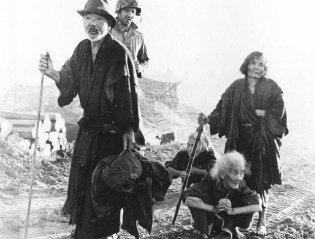
Readjusting the front lines of XXIV Corps to allow room for the 27th Division took time; so did building up adequate units of fire for field artillery battalions to support the mammoth, three-division offensive General Buckner wanted. A week of general inactivity passed along the southern front, which inadvertently allowed the Japanese to make their20 own adjustments and preparations for the coming offensive. On 18 April (L plus 17) Buckner moved the command post of the Tenth Army ashore. The offensive began the next morning, preceded by the ungodliest preliminary bombardment of the ground war, a virtual “typhoon of steel” delivered by 27 artillery batteries, 18 ships, and 650 aircraft. But the Japanese simply burrowed deeper into their underground fortifications and waited for the infernal pounding to cease and for American infantry to advance into their well-designed killing traps.
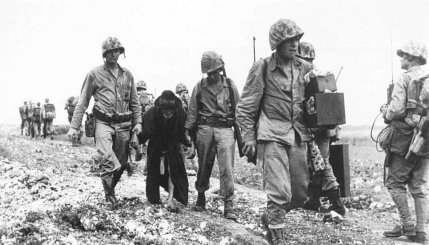
Department of Defense Photo (USMC) 116356
Two Marines help an aged Okinawan to safety in the rear of the lines, as a third Marine of the party carries the man’s meager possessions. Only children, women, and the aged and infirm were found and protected by assaulting Marines as they pushed across the island during the first few days following the 1 April landing.
The XXIV Corps executed the assault on 19 April with great valor, made some gains, then were thrown back with heavy casualties. The Japanese also exacted a heavy toll of U.S. tanks, especially those supporting the 27th Infantry Division. In the fighting around Kakazu Ridge, the Japanese had separated the tanks from their supporting infantry by fire, then knocked off 22 of the 30 Shermans with everything from 47mm guns to hand-delivered satchel charges.
The disastrous battle of 19 April provided an essential dose of reality to the Tenth Army. The so-called “walk in the sun” had ended. Overcoming the concentric Japanese defenses around Shuri was going to require several divisions, massive firepower, and time—perhaps a very long time. Buckner needed immediate help along the Machinato-Kakazu lines. His operations officer requested General Geiger to provide the 1st Tank Battalion to the 27th Division. Hearing this, General del Valle became furious. “They can have my division,” he complained to Geiger, “but not piece-meal.” Del Valle had other concerns. Marine Corps tankers and infantry trained together as teams. The 1st Marine Division had perfected tank-infantry offensive attacks in the crucible of Peleliu. Committing the tanks to the Army without their trained infantry squads could have proven disastrous.
Fortunately, Geiger and Oliver P. Smith made these points clear to General Buckner. The Tenth Army commander agreed to refrain from piece-meal commitments of the Marines. Instead, on 24 April, he requested Geiger to designate one division as Tenth Army Reserve and make one regiment in that division ready to move south in 12 hours. Geiger gave the mission to the 1st Marine Division; del Valle alerted the 1st Marines to be ready to move south.
These decisions occurred while Buckner and his senior Marines were still debating the possibility of opening a second front with an amphibious landing on the Minatoga Beaches. But the continued bloody fighting along the Shuri front received the forefront of Buckner’s attention. As his casualties grew alarmingly, Buckner decided to concentrate all his resources on a single front. On 27 April he assigned the 1st Marine Division to XXIV Corps. During the next three days the division moved south to relieve the shot-up 27th Infantry Division on the western (right) flank of the lines. The 6th Marine Division received a warning order to prepare for a similar displacement to the south. The long battle for Okinawa’s southern highlands was shifting into high gear.
Meanwhile, throughout April and with unprecedented ferocity, the Japanese kamikazes had punished the ships of the Fifth Fleet supporting the operation. So intense had the aerial battles become that the western beaches, so beguilingly harmless on L-Day, became positively deadly each night with the steady rain of shell fragments from thousands of antiaircraft guns in the fleet. Ashore or afloat, there were no safe havens in this protracted battle.
The Japanese strategy for defending Okinawa made the most of that nation’s dwindling resources and rampant fanaticism. While General Ushijima bloodied the American landing force in a protracted battle of attrition, the Japanese air arm would savage the Fifth Fleet tethered to the island in support. The battle would thus feature the unique combination of a near-passive ground defense with a violent air offensive that would employ suicide tactics on an unprecedented scale.
By the spring of 1945 the Americans knew well the Japanese propensity for individual suicide attacks, having experienced kamikazes in the Philippines, antishipping swimmers21 in the waters near Iwo Jima, and “human bullet” antitank demolitionists at Peleliu. But IGHQ escalated these tactics to an awesome level at Okinawa by introducing the kikusui (Floating Chrysanthemums) massed suicide air strikes against the fleet. While small groups of kamikazes struck the fleet on a nightly basis, the worst damage came from the concentrated kikusui raids. The Japanese launched ten separate kikusui attacks during the battle—some of them numbering up to 350 aircraft—and IGHQ coordinated many of these with other tactical surprises, such as the counterattacks of 12–13 April and 3–4 May or the sacrificial sortie of the Yamato. The results proved costly to both sides.
Swarms of kamikazes bedeviled the Fifth Fleet from the time the advance force first steamed into Ryukyuan waters throughout the course22 of the battle. Some intermediate Navy commanders spoke dismissively of the threat—inexperienced pilots in ramshackle planes launched with barely enough fuel to reach Okinawa. Indeed, many of the 2,373 kamikazes never made it to the objective. But those Special Attack Unit pilots who survived the air and surface screens inflicted grievous damage on the Fifth Fleet. By the end of the campaign, the fleet had suffered 34 ships and craft sunk, 368 damaged, and more than 9,000 casualties—the greatest losses ever sustained by the U.S. Navy in a single battle.

Marine Corps Historical Center
The amphibious task force under one of the first destructive heavy kamikaze attacks off Okinawa’s southwest coast on L plus 5. The kamikazes were to make many such visits to Okinawa before the operation ended, causing much damage.
The situation at sea grew so critical that on one occasion smoke from burning ships and screening escorts offshore blinded Yontan Airfield, causing three returning CAP planes to crash. As the onslaught continued, Admiral Spruance observed frankly, “The suicide plane is a very effective weapon which we must not underestimate.” Spruance spoke from firsthand experience. Kamikazes knocked his first flagship, the heavy cruiser Indianapolis, out of the battle early in the campaign, then severely damaged his replacement flagship, the battleship New Mexico, a few weeks later.
A U.S. ship badly damaged by a kamikaze hit receives a survey inspection within the protected anchorage of Kerama Retto, where the Navy repaired its damaged fleet.
Marine Corps Historical Center
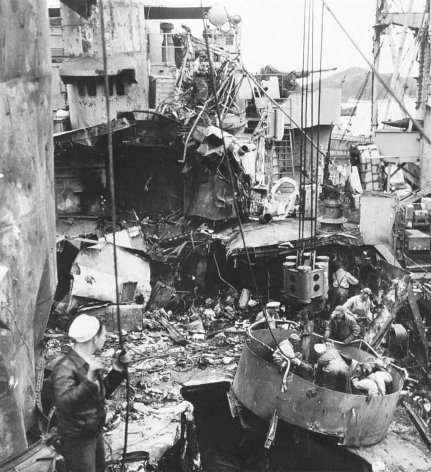
The Japanese attacking the U.S. fleet off Okinawa also introduced their newest weapon, the “Ohka” (cherry blossom) bomb (called by the Americans “Baka,” a derisive Japanese term meaning “foolish”). It was a manned, solid-fuel rocket packed with 4,400 pounds of explosives, launched at ships from the belly of a twin-engined bomber. The Baka bombs became in effect the first antiship guided missiles, screaming towards the target at an unheard-of 500 knots. One such weapon blew the destroyer Manert L. Abele out of the water. Fortunately, most of the Bakas missed their targets, the missiles proving too fast for inexperienced23 pilots to control in their few seconds of glory.
The ultimate suicide attack was the final sortie of the superbattleship Yamato, the last of the world’s great dreadnoughts, whose feared 18.1-inch guns could outrange the biggest and newest U.S. battleships. IGHQ dispatched Yamato on her last mission, a bizarre scheme, with no air cover and but a handful of surface escorts and only enough fuel for a one-way trip. She was to distract the American carriers to allow a simultaneous kikusui attack against the remainder of the fleet. Achieving this, Yamato would beach itself directly on Okinawa’s west coast, using her big guns to shoot up the thin-skinned amphibious shipping and the landing force ashore. The plan proved absurd.
In earlier years of the war the sortie of this mammoth warship would have caused consternation among the fleet protecting an amphibious beachhead. Not now. Patrolling U.S. submarines gave Spruance early warning of Yamato’s departure from Japanese waters. “Shall I take them or will you?” asked Vice Admiral Marc A. Mitscher, commanding the fast carriers of Task Force 58. Spruance knew his battleship force yearned for a surface battle to avenge their losses at Pearl Harbor, but this was no time for sentiment. “You take them,” he signaled. With that, Mitscher’s Hellcats and Avengers roared aloft, intercepted Yamato a hundred miles from the beachhead, and sank her in short order with bombs and torpedoes. The cost: eight U.S. planes, 12 men.
Another bizarre Japanese suicide mission proved more effective. On the night of 24–25 May, a half-dozen transport planes loaded with Giretsu, Japanese commandos, approached the U.S. airbase at Yontan. Alert antiaircraft gunners flamed five. The surviving plane made a wheels-up belly landing on the airstrip, discharging troops as she slid in sparks and flames along the surface. The commandos blew up eight U.S. planes, damaged twice as many more, set fire to 70,000 gallons of aviation gasoline, and generally created havoc throughout the night. Jittery aviation and security troops fired at shadows, injuring their own men more than the Japanese. It took 12 hours to hunt down and kill the last raider.
Japanese night raiders are met on 16 April with a spectacular network of antiaircraft fire by Marine defenders based at Yontan airfield. In the foreground, silhouetted against the interlaced pattern of tracer bullets, are Corsairs of VMF-311.
Department of Defense Photo (USMC) 118775
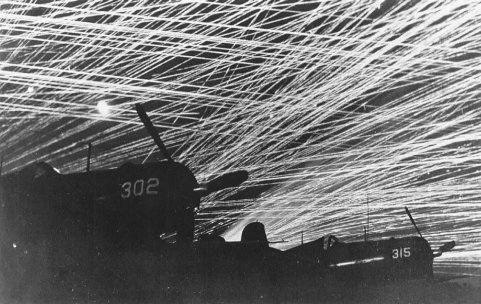
Admiral Spruance at sea and General Mulcahy ashore exerted Herculean efforts to reduce the effectiveness of these suicide strikes. The fast carriers struck Japanese airfields in Kyushu and Formosa time and again, but these numbered more than 100, and as usual the Japanese proved adept at camouflage. Small landing parties of soldiers and Marines seized outlying islands (see sidebar) to establish early warning and fighter direction outposts. And fighter planes from all three services took to the air to intercept the intermittent waves of enemy planes.
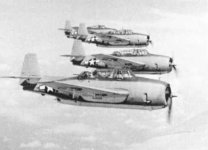
Department of Defense Photo (USMC) 121884
Marine Avengers of Marine Torpedo-Bomber Squadron 232 are seen through the hatch of a transport, which served as a navigation plane for the overwater flight from Ulithi to Kadena. The flight echelon landed on 22 April and began close-support missions the next day.
Not all of the Japanese air strikes were kamikazes. An equal number of fighters and bombers accompanied each raid to guide the suiciders to their targets and attack American targets by conventional means. Some of these included late-model fighters like the Nakajima “Frank.” Deadly air-to-air duels took place over hundreds of miles of ocean expanse.
The far-ranging fast carriers usually made the first interceptions. While most pilots were Navy, the task force included two Marine fighter squadrons each on the carriers Bunker Hill and Bennington. One Marine aviator from Bennington, Lieutenant Kenneth E. Huntington, flew the only USMC Corsair in the attack on Yamato. Huntington swept in through heavy AA fire to deliver his bomb squarely on the battleship’s forward turret. As described by combat correspondent Robert Sherrod, “One Marine, one bomb, one Navy Cross.”
Marine fighters of MAGs-31 and -33, flying from Yontan under General Mulcahy’s TAF, provided most of the CAP missions over the fleet during the first several weeks of the battle. The CAP requirement soared from 12 planes initially to as many as 32 on station, with an additional dozen on strip alert. The missions involved long hours of patrolling, typically in rough weather spiked by sudden violent encounters with Japanese raiders. The CAP planes ran a double risk. Dueling a Japanese fighter often took both planes within range of nervous shipboard AA gunners who sometimes downed both antagonists unwittingly.
On 16 April, VMF-441 raced to the rescue of the picket ship Laffey, already hit by five suiciders. The Corsairs shot down 17 attackers in short order, losing only one plane which had chased a kamikaze so low they both clipped the ship’s superstructure and crashed.
On 22 April, the “Death Rattlers” of VMF-323 intercepted a large flight of raiders approaching the fleet at dusk. Three Marines shot down 16 of these in 20 minutes. The squadron commander, Major George C. Axtell, knocked down five, becoming an instant ace. As Axtell described these sudden dogfights:
You’d be flying in and out of heavy rain and clouds. Enemy and friendly aircraft would wind up in a big melee. You just kept turning into any enemy aircraft that appeared.... It was fast and furious and the engagement would be over within thirty minutes.
A “Grasshopper” from a Marine observation squadron flies over Naha, permitting an aerial photographer to take oblique photos which will be used by Marine artillery units to spot targets and determine the damage already done by the Allies.
Department of Defense Photo (USMC) 128032
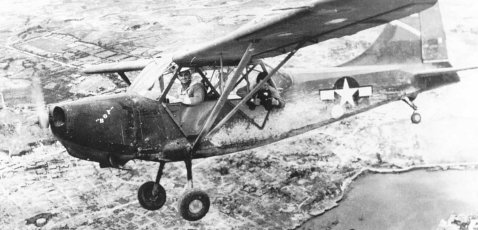
But in spite of the heroic efforts of all these aviators and their ground26 crews, the kamikazes swarmed in such numbers that a few always got through. Soon, the protected anchorage at Kerama Retto began to resemble a floating graveyard of heavily damaged ships. Small groups of suiciders appeared every night, and the fleet seemed particularly vulnerable during the full moon. One naval officer described the night-time raiders as “witches on broomsticks.” More often than not, the victims of these nocturnal attacks were the “small boys,” the picket ships and diminutive amphibs. Nineteen-year-old Signalman 3/C Nick Floros manned a 20mm gun mount on tiny LSM-120 one midnight when a kamikaze appeared “out of nowhere, gliding in low with its engine cut off—like a giant bat.” The plane struck the adjacent LSM with a terrific explosion before anyone could fire a shot. The small landing ship, loaded with landing force supplies, somehow survived the fiery blast but was immediately consigned to the “demolition yard” at Kerama Retto.
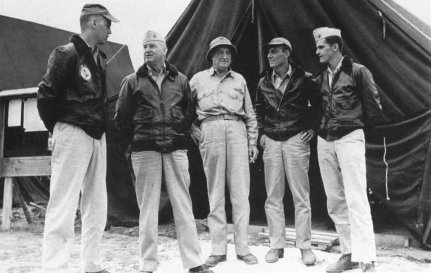
Department of Defense Photo (USMC) 119294
During a visit to Marines in late April, the Commandant, Gen Alexander A. Vandegrift, second from left, called on MajGen Francis P. Mulcahy, center, commander of the Tactical Air Force, Tenth Army, and three of his pilots: Maj George C. Axtell, Jr., left; Maj Jefferson D. Dorroh, second from right; and Lt Jeremiah J. O’Keefe. Maj Axtell commanded VMF-323, the “Death Rattlers.”
Imperial General Headquarters, accepting the inflated claims of the few observers accompanying the kikusui attacks, believed their suicidal air offensive had fatally crippled the U.S. Fleet. This was wishful thinking. The Fifth Fleet may have been stressed and battered by the kamikazes, but it was simply too huge a force to be deterred. The fleet withstood the worst of these seemingly endless air attacks without for a moment forsaking its primary mission of supporting the amphibious assault on Okinawa. Naval gunfire support, for example, had never been so thoroughly effective, beginning with the 3,800 tons of munitions delivered on L-Day. Throughout much of the campaign, each front-line regiment received direct support from one “call fire” ship and one “illumination ship.” Typical of the appreciation most members of the landing force expressed for the quality of naval gunfire support was this message from General Shepherd to the Commander, Northern Attack Force during the 6th Marine Division’s assault on Mount Yae Take: “The effectiveness of your gunfire support was measured by the large number of Japanese encountered. Dead ones.”
Similarly, even during the most intense of the kikusui attacks of 1–16 April, the fleet unloaded an astonishing 557,000 tons of supplies over the Hagushi Beaches to support the Tenth Army, executed the division-level assault on Ie Shima, and cleared mines and obstacles under fire to open the port of Nago. The only direct effect the mass kamikaze raids ever had on the conduct of Tenth Army operations ashore was the sinking on 6 April of the ammunition ships Logan Victory and Hobbs Victory. The subsequent shortage of 105mm and 155mm artillery ammunition delayed General Buckner’s first great offensive against the outer Shuri defenses by about three days. In all respects, the Fifth Fleet deserved its media sobriquet as “The Fleet That Came to Stay.”
But as April dragged into May, and the Tenth Army seemed bogged down in unimaginative frontal attacks along the Shuri line, Admirals Spruance and Turner began to press General Buckner to accelerate his tactics in order to decrease the vulnerability of the fleet. Admiral Nimitz, quite concerned, flew to Okinawa to counsel Buckner. “I’m losing a ship and a half each day out here,” Nimitz said, “You’ve got to get this thing moving.”
The senior Marines urged Buckner to “play the amphib card,” to execute a major landing on the southeast coast, preferably along the alternate beaches at Minatoga, in order to turn the Japanese right flank. They were joined in this recommendation by several Army generals who already perceived what a meatgrinder the frontal assaults along the Shuri line would become. The Commandant of the Marine Corps, General Alexander A. Vandegrift, visited the island and seconded these suggestions to Buckner. After all, Buckner still had control of the 2d Marine Division, a veteran amphibious outfit which had demonstrated effectively against the Minatoga Beaches on L-Day. Buckner had subsequently returned the embarked division to Saipan to reduce its vulnerability to additional kamikaze attacks, but the27 unit still had its assigned ships at hand, still combat loaded. The 2d Marine Division could have opened a second front in Okinawa within a few days.

Department of Defense Photo (USMC) 120053
All Marines sight-in on the mouth of a cave into which an explosive charge had been thrown, and wait to see if any enemy soldiers will try to escape. This is one of the many bitterly contested cave positions found in numerous ridges and hills.
General Buckner was a popular, competent commander, but he had limited experience with amphibious warfare and possessed a conservative nature. His staff warned of logistics problems involved in a second front. His intelligence advisors predicted stiff enemy resistance around the Minatoga beachhead. Buckner had also heard enough of the costly Anzio operation in Italy to be leery of any landing executed too far from the main effort. He honestly believed the Japanese manning the Shuri defenses would soon crack under the synchronized application of all his massed firepower and infantry. Buckner therefore rejected the amphibious option out of hand. Surprisingly, Nimitz and his Chief of Staff, Rear Admiral Forrest Sherman, agreed. Not so Admirals Spruance and Turner or the Marines. As Spruance later admitted in a private letter, “There are times when I get impatient for some of Holland Smith’s drive.” General Shepherd noted, “General Buckner did not cotton to amphibious operations.” Even Colonel Hiromichi Yahara, Operations Officer of the Thirty-second Army, admitted under interrogation that he had been baffled by the American’s adherence to a purely frontal assault from north to south. “The absence of a landing [in the south] puzzled the Thirty-second Army staff,” he said, “particularly after the beginning of May when it became impossible to put up more than a token resistance in the south.”
By then the 2d Marine Division was beginning to feel like a yo-yo in preparing for its variously assigned missions for Operation Iceberg. Lieutenant Colonel Taxis, Division G-3, remained unforgiving of Buckner’s decision. “I will always feel,” he stated after the war, “that the Tenth Army should have been prepared the instant they found they were bogged down, they should have thrown a left hook down there in the southern beaches.... They had a hell of a powerful reinforced division, trained to a gnat’s whisker.”
Buckner stood by his decision. There would be no “left hook.” Instead, both the 1st and the 6th Marine Divisions would join the Shuri offensive as infantry divisions under the Tenth Army. The 2d Marine Division, less one reinforced regimental landing team (the 8th Marines), would languish back in Saipan. Then came Okinawa’s incessant spring rains.
The Tenth Army’s Action Report for the battle of Okinawa paid this understated compliment to the Thirty-second Army’s defensive efforts:28 “The continued development and improvement of cave warfare was the most outstanding feature of the enemy’s tactics on Okinawa.” In their decision to defend the Shuri highlands across the southern neck of the island, General Ushijima and his staff had selected the terrain that would best dominate two of the island’s strategic features: the port of Naha to the west, and the sheltered anchorage of Nakagusuku Bay (later Buckner Bay) to the east. As a consequence, the Americans would have to force their way into Ushijima’s preregistered killing zones to achieve their primary objectives.
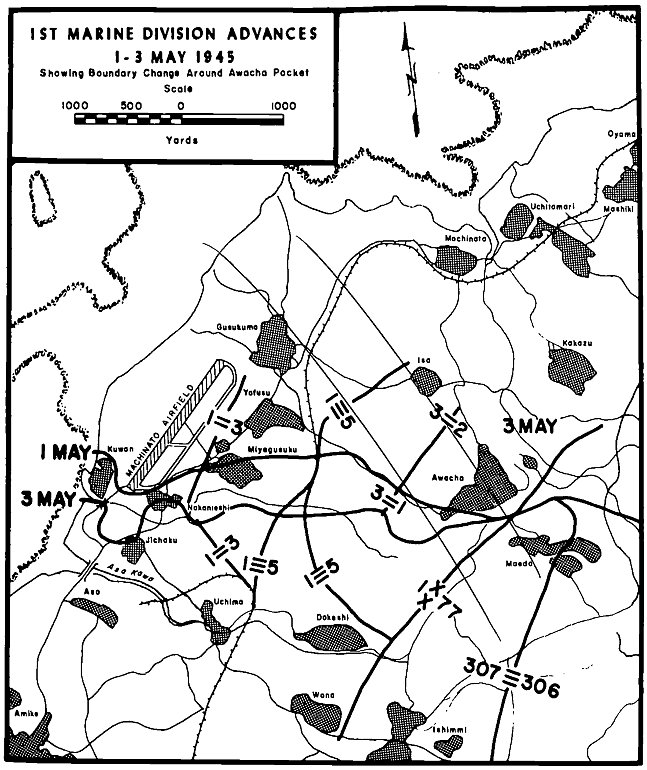
1ST MARINE DIVISION ADVANCES
1–3 MAY 1945
Showing Boundary Change Around Awacha Pocket
Everything about the terrain favored the defenders. The convoluted topography of ridges, draws, and escarpments served to compartment the battlefield into scores of small firefights, while the general absence of dense vegetation permitted the defenders full observation and interlocking supporting fires from intermediate strongpoints. As at Iwo Jima, the Japanese Army fought largely from underground positions to offset American dominance in supporting arms. And even in the more accessible terrain, the Japanese took advantage of the thousands of concrete, lyre-shaped Okinawan tombs to provide combat outposts. There were blind spots in the defenses, to be sure, but finding and exploiting them took the Americans an inordinate amount of time and cost them dearly.
The bitterest fighting of the campaign took place within an extremely compressed battlefield. The linear distance from Yonabaru on the east coast to the bridge over the Asa River above Naha on the opposite side of the island is barely 9,000 yards. General Buckner initially pushed south with two Army divisions abreast. By 8 May he had doubled this commitment: two Army divisions of the XXIV Corps on the east, two Marine divisions of IIIAC on the west. Yet each division would fight its own desperate, costly battles against disciplined Japanese soldiers defending elaborately fortified terrain features. There was no easy route south.
By eschewing the amphibious flanking attack in late April, General Buckner had fresh divisions to employ in the general offensive towards Shuri. Thus, the 77th Division relieved the 96th in the center, and the 1st Marine Division began relieving the 27th Division on the west. Colonel Kenneth B. Chappell’s 1st Marines entered the lines on the last day of April and drew heavy fire from the moment they approached. By the time the 5th Marines arrived to complete the relief of 27th Division elements on 1 May, Japanese gunners supporting the veteran 62d Infantry Division were pounding anything that moved. “It’s hell in there, Marine,” a dispirited soldier remarked to Private First Class Sledge as 3/5 entered the lines. “I know,” replied Sledge with false bravado, “I fought at Peleliu.” But soon Sledge was running for his life:
As we raced across an open field, Japanese shells of all types whizzed, screamed, and roared around us with increasing frequency. The crash and thunder of explosions was a nightmare.... It was an appalling chaos. I was terribly afraid.
General del Valle assumed command of the western zone at 1400 on 1 May and issued orders for a major attack the next morning. That evening a staff officer brought the general a captured Japanese map, fully annotated with American positions. With growing uneasiness, del Valle realized his opponents already knew29 the 1st Marine Division had entered the fight.
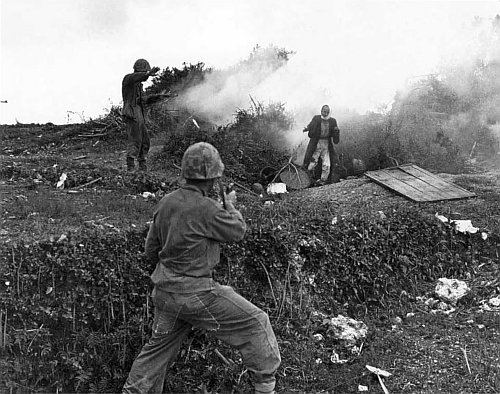
Department of Defense Photo (USMC) 125697
An Okinawan civilian is flushed from a cave into which a smoke grenade had been thrown. Many Okinawans sought the refuge of caves in which they could hide while the tide of battle passed over them. Unfortunately, a large number of caves were sealed when Marines suspected that they were harboring the enemy.
The division attacked south the next day into broken country thereafter known as the Awacha Pocket. For all their combat prowess, however, the Marines proved to be no more immune to the unrelenting storm of shells and bullets than the soldiers they had relieved. The disappointing day also included several harbingers of future conditions. First, it rained hard all day. Second, as soon as the 5th Marines seized the nearest high ground they came under such intense fire from adjacent strongpoints and from higher ground within the 77th Division’s zone to the immediate southeast they had to withdraw. Third, the Marines spent much of the night engaged in violent hand-to-hand fighting with scores of Japanese infiltrators. “This,” said one survivor, “is going to be a bitch.”
The Peleliu veterans in the ranks of the 1st Marine Division were no strangers to cave warfare. Clearly, no other division in the campaign could claim such a wealth of practical experience. And while nothing on Okinawa could match the Umurbrogol’s steep cliffs, heavy vegetation, and endless array of fortified ridges, the “Old Breed” in this battle faced a smarter, more numerous foe who had more artfully prepared each wrinkle in the moonscape. In overcoming the sequential barriers of Awacha, Dakeshi, and Wana, the 1st Marine Division faced four straight weeks of hell. The funneling effects of the cliffs and draws reduced most attacks to brutal frontal assaults by fully-exposed tank-infantry-engineer teams. General del Valle characterized this small unit fighting as “a slugging match with but temporary and limited opportunity to maneuver.”
General Buckner captured the fancy of the media with his metaphor about the “blowtorch and corkscrew” tactics needed for effective cave warfare, but this was simply stating the obvious to the Army veterans of Biak and the Marine veterans of Peleliu and Iwo Jima. Flamethrowers were represented by the blowtorch, demolitions, by the corkscrew—but both weapons had to be delivered from close range by tanks and the exposed riflemen covering them.
On 3 May the rains slowed and the 5th Marines resumed its assault, this time taking and holding the first tier of key terrain in the Awacha Pocket. But the systematic reduction of this strongpoint would take another full week of extremely heavy fighting. Fire support proved excellent. Now it was the Army’s time to return the favor of interservice artillery support. In this case, the 27th Division’s field artillery regiment stayed on the lines, and with its forward observers and linemen intimately familiar with the terrain in that sector, rendered yeoman service.
A “Ronson” tank, mounting a flame thrower, lays down a stream of fire against a position located in one of the many Okinawan tombs set in the island’s hillsides.
Department of Defense Photo (USMC) 122153
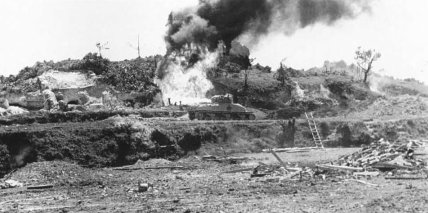
30 At this point an odd thing happened, an almost predictable chink in the Japanese defensive discipline. The genial General Ushijima permitted full discourse from his staff regarding tactical courses of action. Typically, these debates occurred between the impetuous chief of staff, Lieutenant General Isamu Cho, and the conservative operations officer, Colonel Hiromichi Yahara. To this point, Yahara’s strategy of a protracted holding action had prevailed. The Thirty-second Army had resisted the enormous American invasion successfully for more than a month. The army still intact, could continue to inflict high casualties on the enemy for months to come, fulfilling its mission of bleeding the ground forces while the “Divine Wind” wreaked havoc on the fleet. But maintaining a sustained defense was anathema to a warrior like Cho, and he argued stridently for a massive counterattack. Against Yahara’s protests, Ushijima sided with his chief of staff.
The great Japanese counterattack of 4–5 May proved ill-advised and exorbitant. To man the assault forces, Ushijima had to forfeit his coverage of the Minatoga sector and bring those troops forward into unfamiliar territory. To provide the massing of fires necessary to cover the assault he had to bring most of his artillery pieces and mortars out into the open. And his concept of using the 26th Shipping Engineer Regiment and other special assault forces in a frontal attack, and, at the same time, a waterborne, double envelopment would alert the Americans to the general counteroffensive. Yahara cringed in despair.
Marines of the 1st Division move carefully toward the crest of a hill on their way to Dakeshi. The forwardmost Marines stay low, off of the skyline.
Department of Defense Photo (USMC) 120412
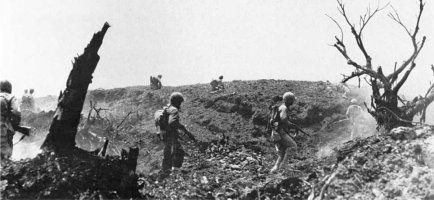
The events of 4–5 May proved the extent of Cho’s folly. Navy “Flycatcher” patrols on both coasts interdicted the first flanking attacks conducted by Japanese raiders in slow-moving barges and native canoes. Near Kusan, on the west coast, the 1st Battalion, 1st Marines, and the LVT-As of the 3d Armored Amphibian32 Battalion greeted the invaders trying to come ashore with a deadly fire, killing 700. Further along the coast, 2/1 intercepted and killed 75 more, while the 1st Reconnaissance Company and the war dog platoon tracked down the last 65 hiding in the brush. Meanwhile the XXIV Corps received the brunt of the overland thrust and contained it effectively, scattering the attackers into small groups, hunting them down ruthlessly. The 1st Marine Division, instead of being surrounded and annihilated in accordance with the Japanese plan, launched its own attack instead, advancing several hundred yards. The Thirty-second Army lost more than 6,000 first-line troops and 59 pieces of artillery in the futile counterattack. Ushijima, in tears, promised Yahara he would never again disregard his advice. Yahara, the only senior officer to survive the battle, described the disaster as “the decisive action of the campaign.”
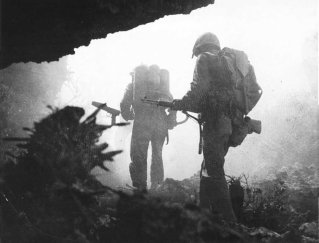
Marine Corps Historical Center
In the end, victory was achieved at Okinawa by well-trained assault troops on the ground, like this Marine flamethrower operator and his watchful rifleman.
At this point General Buckner decided to make it a four-division front and ordered General Geiger to redeploy the 6th Marine Division south from the Motobu Peninsula. General Shepherd quickly asked Geiger to assign his division to the seaward flank to continue the benefit of direct naval gunfire support. “My G-3, Brute Krulak, was a naval gunfire expert,” Shepherd said, noting the division’s favorable experience with fleet support throughout the northern campaign. Unspoken was an additional benefit: Shepherd would have only one adjacent unit with which to coordinate fire and maneuver, and a good one at that, the veteran 1st Marine Division.
Men of the 7th Marines wait until the exploding white phosphorous shells throw up a thick-enough smoke screen to enable them to advance in their drive towards Shuri. The smoke often concealed the relentlessly attacking troops.
Department of Defense Photo (USMC) 120182
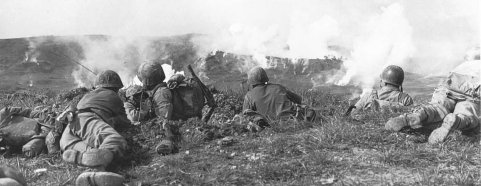
On the morning of 7 May General Geiger regained control of the 1st Marine Division and his Corps Artillery from XXIV Corps and established his forward CP. The next day the 22d Marines relieved the 7th Marines in the lines north of the Asa River. The 1st Marine Division, which had suffered more than 1,400 casualties in its first six days on the lines while trying to cover a very33 wide front, adjusted its boundaries gratefully to make room for the newcomers.
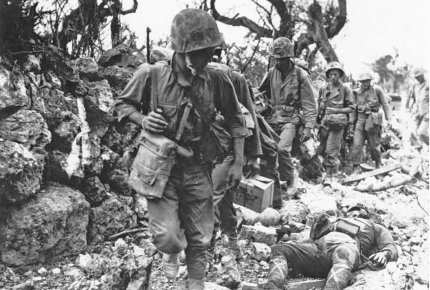
Department of Defense Photo (USMC) 119485
Heading south toward Shuri Castle, a 1st Marine Division patrol passes through a small village which had been unsuccessfully defended by Japanese troops.
Yet the going got no easier, even with two full Marine divisions now shoulder-to-shoulder in the west. Heavy rains and fierce fire greeted the 6th Marine Division as its regiments entered the Shuri lines. The situation remained as grim and deadly all along the front. On 9 May, 1/1 made a spirited attack on Hill 60 but lost its commander, Lieutenant Colonel James C. Murray, Jr., to a sniper. Nearby that night, 1/5 engaged in desperate hand-to-hand fighting with a force of 60 Japanese soldiers who appeared like phantoms out of the rocks.
The heavy rains caused problems for the 22d Marines in its efforts to cross the Asa River. The 6th Engineers fabricated a narrow footbridge under intermittent fire one night. Hundreds of infantry raced across before two Japanese soldiers wearing satchel charges strapped to their chests dashed into the stream and blew themselves and the bridge to kingdom come. The engineers then spent the next night building a more substantial Bailey Bridge. Across it poured reinforcements and vehicles, but the tanks played hell traversing the soft mud along both banks—each attempt was an adventure. Yet the 22d Marines were now south of the river in force, an encouraging bit of progress on an otherwise stalemated front.
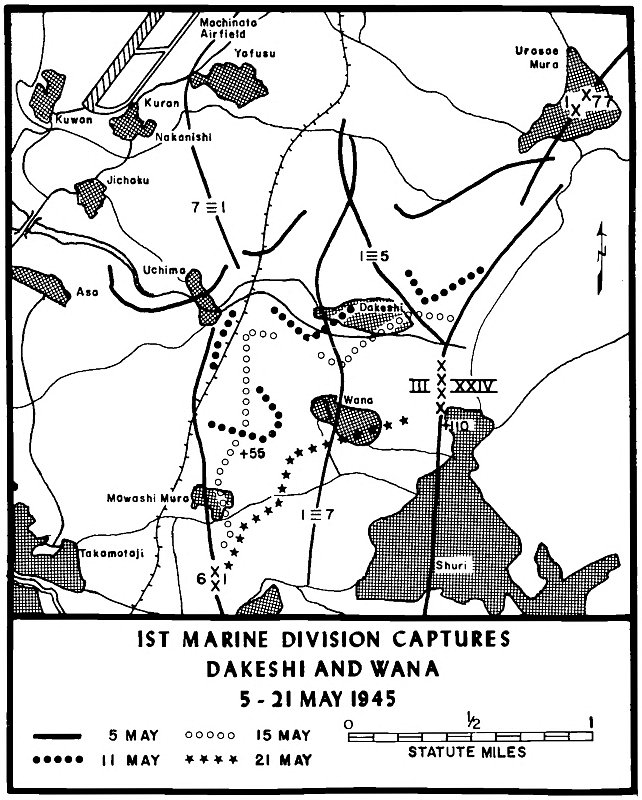
1ST MARINE DIVISION CAPTURES
DAKESHI AND WANA
5–21 MAY 1945
The 5th Marines finally fought clear of the devilish Awacha Pocket on the 10th, ending a week of frustration and point-blank casualties. Now it became the turn of the 7th Marines to engage its own nightmare terrain. Due south of their position lay Dakeshi Ridge. Coincidentally, General Buckner prodded his commanders on the 11th, announcing a renewed general offensive along the entire front. This proclamation may well have been in response to the growing criticism Buckner had been34 receiving from the Navy and some of the media for his time-consuming attrition strategy. But the riflemen’s war had progressed beyond high-level exhortation. The assault troops knew fully what to expect—and what it would likely cost.
35 The 7th Marines was an experienced outfit and well commanded by Guadalcanal and Bougainville veteran Colonel Edward W. Snedeker. “I was especially fortunate at Okinawa,” he said, “in that each of my battalion commanders had fought at Peleliu.” Nevertheless, the regiment had its hands full with Dakeshi Ridge. “It was our most difficult mission,” said Snedeker. After a day of intense fighting, Lieutenant Colonel John J. Gormley’s 1/7 fought its way to the crest of Dakeshi, but had to withdraw under swarming Japanese counterattacks. The next day, Lieutenant Colonel Spencer S. Berger’s 2/7 regained the crest and cut down the counterattackers emerging from their reverse-slope bunkers. The 7th Marines were on Dakeshi to stay, another significant breakthrough.
“The Old Breed” Marines enjoyed only a brief elation at this achievement because from Dakeshi they could glimpse the difficulties yet to come. In fact, the next 1,200 yards of their advance would eat up 18 days of fighting. In this case, seizing Wana Ridge would be tough, but the most formidable obstacle would be steep, twisted Wana Draw that rambled just to the south, a deadly killing ground, surrounded by towering cliffs pocked with caves, with every possible approach strewn with mines and covered by interlocking fire. “Wana Draw proved to be the toughest assignment the 1st Division was to encounter,” reported General Oliver P. Smith. The remnants of the 62d Infantry Division would defend Wana to their deaths.
Because the 6th Marine Division’s celebrated assault on Sugar Loaf Hill occurred during the same period, historians have not paid as much attention to the 1st Division’s parallel efforts against the Wana defenses. But Wana turned out to be almost as deadly a “mankiller” as Sugar Loaf and its bloody environs. The 1st Marines, now led by Colonel Arthur T. Mason, began the assault on the Wana complex on 12 May. In time, all three infantry regiments would take their turn attacking the narrow gorge to the south. The division continued to make full use of its tank battalion. The Sherman medium tanks and attached Army flame tanks were indispensable in both their assault and direct fire support roles (see sidebar). On 16 May, as an indicator, the 1st Tank Battalion fired nearly 5,000 rounds of 75mm and 173,000 rounds of .30-caliber ammunition, plus 600 gallons of napalm.
Crossing the floor of the gorge continued to be a heart-stopping race against a gauntlet of enemy fire, however, and progress came extremely slowly. Typical of the fighting was the division’s summary for its aggregate progress on 18 May: “Gains were measured by yards won, lost, then won again.” On 20 May, Lieutenant Colonel Stephen V. Sabol’s 3/1 improvised a different method of dislodging Japanese defenders from their reverse-slope positions in Wana Draw. In five hours of muddy, back-breaking work, troops manhandled several drums of napalm up the north side of the ridge. There the Marines split the barrels open, tumbled them down into the gorge, and set them ablaze by dropping white phosphorous grenades in their wake. But each small success seemed to be undermined by the Japanese ability to reinforce and resupply their positions during darkness, usually screened by mortar barrages or small-unit counterattacks. The fighting in such close quarters was vicious and deadly. General del Valle watched in alarm as his casualties mounted daily. The 7th Marines, which lost 700 men taking Dakeshi, lost 500 more in its first five days fighting for the Wana complex. During 16–19 May, Lieutenant Colonel E. Hunter Hurst’s 3/7 lost 12 officers among the rifle companies. The other regiments suffered proportionately. Throughout the period 11–30 May, the division would lose 200 Marines for every 100 yards advanced.
Heavy rains resumed on 22 May and continued for the next ten days. The 1st Marine Division’s sector contained no roads. With his LVTs committed to delivering ammunition and extracting casualties, del Valle resorted to using his replacement drafts to hand-carry food and water to the front lines. This proved less than satisfactory. “You can’t move it all on foot,” noted del Valle. Marine torpedo bombers flying out of Yontan began air-dropping supplies by parachute, even though low ceilings, heavy rains, and enemy fire made for hazardous duty. The division commander did everything in his power to keep his troops supplied, supported, reinforced, and motivated—but conditions were extremely grim.
To the west, the neighboring 6th Marine Division’s advance south below the Asa River collided against a trio of low hills dominating the open country leading up to Shuri Ridge. The first of these hills—steep but unassuming—became known as Sugar Loaf. To the southeast lay Half Moon Hill, to the southwest Horseshoe Hill and the village of Takamotoji. The three hills represented a singular defensive complex; in fact they were the western anchor of the Shuri Line. So sophisticated were the mutually supporting defenses of the three hills that an attack on one would prove futile unless the others were simultaneously invested. Colonel Seiko Mita and his 15th Independent Mixed Regiment defended this sector. Its mortars and antitank guns were particularly well-sited on Horseshoe. The western slopes of Half Moon contained some of the most effective machine gun nests the Marines had yet encountered. Sugar Loaf itself contained36 elaborate concrete-reinforced reverse-slope positions. And all approaches to the complex fell within the beaten zone of heavy artillery from Shuri Ridge which dominated the battlefield.

Department of Defense Photo (USMC) 124745
Sugar Loaf, western anchor of the Shuri defenses, and objective of the 22d Marines, is seen from a point directly north.
Battlefield contour maps indicate Sugar Loaf had a modest elevation of 230 feet; Half Moon, 220; Horseshoe, 190. In relative terms, Sugar Loaf, though steep, only rose about 50 feet above the northern approaches. This was no Mount Suribachi; its significance lay in the ingenuity of its defensive fortifications and the ferocity with which General Ushijima would counterattack each U.S. penetration. In this regard, the Sugar Loaf complex more closely resembled a smaller version of Iwo Jima’s Turkey Knob/Amphitheater sector. As a tactical objective, Sugar Loaf itself lacked the physical dimensions to accommodate anything larger than a rifle company. But eight days of fighting for the small ridge would chew up a series of very good companies from two regiments.
Of all the contestants, American or Japanese, who survived the struggle for Sugar Loaf, Corporal James L. Day, a squad leader from Weapons Company, 2/22, had indisputably the “best seat in the house” to observe the battle. In a little-known aspect of this epic story, Day spent four days and three nights isolated in a shell hole on Sugar Loaf’s western shoulder. This proved to be an awesome but unenviable experience.
Corporal Day received orders on 12 May to recross the Asa River and support the assault of Company G, 2/22, against the small ridge. Day and his squad arrived too late to do much more than cover the fighting withdrawal of the remnants from the summit. The company lost half its number in the day-long assault, including its plucky commander, Captain Owen T. Stebbins, shot in both legs by a Japanese Nambu machine-gunner. Day described Stebbins as “a brave man whose tactical plan for assaulting Sugar Loaf became the pattern for successive units to follow.” Concerned about the unrestricted fire from the Half Moon Hill region, Major Henry A. Courtney, Jr., battalion executive officer, took Corporal Day with him on the 13th on a hazardous trek to the 29th Marines to coordinate the forthcoming attacks. With the 29th then committed to protecting 2/22’s left flank, Courtney assigned Day and his squad in support of Company F for the next day’s assault.
Amtracs, such as these, were pressed into service in the difficult terrain to resupply the Marines on Sugar Loaf and to evacuate the wounded, all the while under fire.
Department of Defense Photo (USMC) 123218

Day’s rifle squad consisted of seven Marines by that time. On the 14th, they joined Fox Company’s assault, reached the hill, scampered up the left shoulder (“you could get to the top in 15 seconds”). Day then received orders to take his squad back around the hill to take up a defensive position on the right (western) shoulder. This took some doing. By late afternoon, Fox Company37 had been driven off its exposed position on the left shoulder, leaving Day with just two surviving squadmates occupying a large shell hole on the opposite shoulder.
During the evening, unknown to Day, Major Courtney gathered 45 volunteers from George and Fox companies and led them back up the left shoulder of Sugar Loaf. In hours of desperate, close-in fighting, the Japanese killed Major Courtney and half his improvised force. “We didn’t know who they were,” recalled Day, “because even though they were only 50 yards away, they were on the opposite side of the crest. Out of visual contact. But we knew they were Marines and we knew they were in trouble. We did our part by shooting and grenading every [Japanese] we saw moving in their direction.” Day and his two men then heard the sounds of the remnants of Courtney’s force being evacuated down the hill and knew they were again alone on Sugar Loaf.
Representing in effect an advance combat outpost on the contested ridge did not particularly bother the 19-year-old corporal. Day’s biggest concerns were letting other Marines know they were up there and replenishing their ammo and grenades. “Before dawn I went back down the hill. A couple of LVTs had been trying to deliver critical supplies to the folks who’d made the earlier penetration. Both had been knocked out just north of the hill. I was able to raid those disabled vehicles several times for grenades, ammo, and rations. We were fine.”
On 15 May, Day and his men watched another Marine assault develop from the northeast. Again there were Marines on the eastern crest of the hill, but fully exposed to raking fire from Half Moon and mortars from Horseshoe. Day’s Marines directed well-aimed rifle fire into a column of Japanese running towards Sugar Loaf from Horseshoe, “but we really needed a machine gun.” Good fortune provided a .30-caliber, air-cooled M1919A4 in the wake of the retreating Marines. But as soon as Day’s gunner placed the weapon in action on the forward parapet of the hole, a Japanese 47mm crew opened up from Horseshoe, killing the Marine and destroying the gun. Now there were just two riflemen on the ridgetop.
Tragedy also struck the 1st Battalion, 22d Marines, on the 15th. A withering Japanese bombardment caught the command group assembled at their observation post planning the next assault. Shellfire killed the commander, Major Thomas J. Myers, and wounded every company commander, as well as the CO and XO of the supporting tank company. Of the death of Major Myers, General Shepherd exclaimed, “It’s the greatest single loss the Division has sustained. Myers was an outstanding leader.” Major Earl J. Cook, battalion executive officer, took command and continued attack preparations. The division staff released this doleful warning that midnight: “Because of the commanding ground which he occupies the enemy is able to accurately locate our OPs and CPs. The dangerous practice of permitting unnecessary crowding and exposure in such areas has already had serious consequences.” The warning was meaningless. Commanders had to observe the action in order to command. Exposure to interdictive fire was the cost of doing business as an infantry battalion commander. The next afternoon, Lieutenant Colonel Jean W. Moreau, commanding 1/29, received a serious wound when a Japanese shell hit his observation post squarely. Major Robert P. Neuffer, Moreau’s exec, assumed command. Several hours later a Japanese shell wounded Major Malcolm “O” Donohoo, commanding 3/22. Major George B. Kantner, his exec, took over. The battle continued.
Tanks evacuate the wounded as men of the 29th Marines press the fight to capture Sugar Loaf. The casualties were rushed to aid stations behind the front lines.
Department of Defense Photo (USMC) 122421

The night of 15–16 seemed endless to Corporal Day and his surviving squadmate, Private First Class Dale Bertoli. “The Japs knew we were the only ones up there and gave us their full attention. We had plenty of grenades and ammo, but it got pretty hairy.” The south slope of Sugar Loaf is the steepest. The Japanese would emerge from their reverse-slope caves, but they faced a difficult ascent to get to the Marines on the military crest. Hearing them scramble up the rocks alerted Day and Bertoli38 to greet them with grenades. Those of the enemy who survived this mini-barrage would find themselves backlit by flares as they struggled over the crest. Day and Bertoli, back to back against the dark side of the crater, shot them readily.
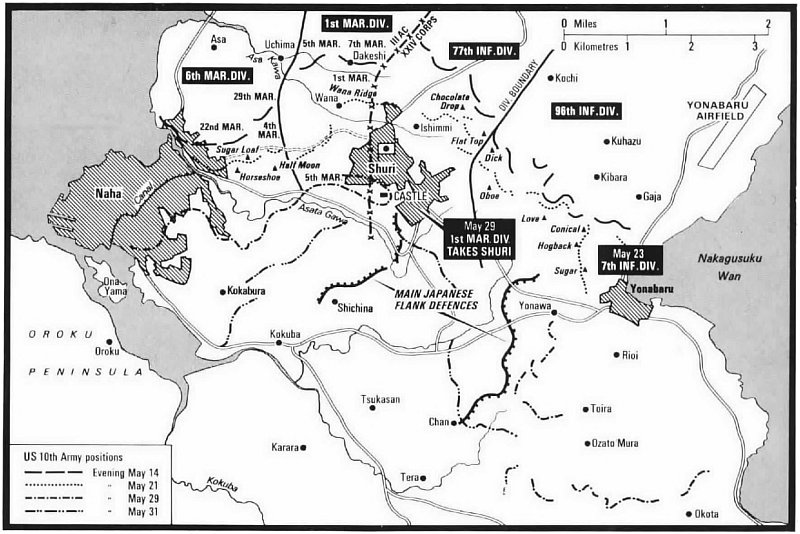
“The 16th was the day I thought Sugar Loaf would fall,” said Day. He and Bertoli hunkered down as Marine tanks, artillery, and mortars pounded the ridge and its supporting bastions. “We looked back and see the whole battle shaping up, a great panorama.” This was the turn of I/3/22, well supported by tanks. But Day could also see that the Japanese fires had not slackened at all. “The real danger at Sugar Loaf was not the hill itself, where we were, but in a 300-yard by 300-yard killing zone which the Marines had to cross to approach the hill from our lines to the north.... It was a dismal sight, men falling, tanks getting knocked out ... the division probably suffered 600 casualties that day.” In retrospect, the 6th Marine Division considered 16 May to be “the bitterest day of the entire campaign.”
By then the 22d Marines was down to 40 percent effectiveness and General Shepherd relieved it with the 29th Marines. He also decided to install fresh leadership in the regiment, replacing the commander and executive officer with the team of Colonel Harold C. Roberts and Lieutenant Colonel August C. Larson.
The weather cleared enough during the late afternoon of the 16th to enable Day and Bertoli to see well past Horseshoe Hill, “all the way to the Asato River.” The view was not encouraging. Steady columns of Japanese reinforcements streamed northward, through Takamotoji village, towards the contested battlefield. “We kept firing on them from 500 yards away,” still maintaining the small but persistent thorn in the flesh of the Japanese defenses. Their rifle fire attracted considerable attention from prowling squads of Japanese raiders that night. “They came at us from 2130 on,” recalled Day, “and all we could do was keep tossing grenades and firing our M-1s.” Concerned Marines north of Sugar Loaf, hearing the nocturnal ruckus, tried to assist with mortar fire. “This helped, but it came a little too close.” Both Day and Bertoli were wounded by Japanese shrapnel and burned by “friendly” white phosphorous.
Early on the 17th a runner from the 29th Marines scrambled up to the shell-pocked crater with orders for the two Marines to “get the hell out.” A massive bombardment by air, naval gunfire, and artillery would soon saturate the ridge in preparation of a fresh assault. Day and Bertoli readily complied. Exhausted, reeking, and partially deafened, they stumbled back to safety and an intense series of debriefings by staff officers. Meanwhile, a thundering bombardment crashed down on the three hills.
The 17th of May marked the fifth day of the battle for Sugar Loaf. Now it was the turn of Easy Company, 2/29, to assault the complex of39 defenses. No unit displayed greater valor, yet Easy Company’s four separate assaults fared little better than their many predecessors. At midpoint of these desperate assaults, the 29th Marines reported to division, “E Co. moved to top of ridge and had 30 men south of Sugar Loaf; sustained two close-in charges; killed a hell of a lot of Nips; moved back to base to reform and are going again; will take it.” But Sugar Loaf would not fall this day. At dusk, after prevailing in one more melee of bayonets, flashing knives, and bare hands against a particularly vicious counterattack, the company had to withdraw. It had lost 160 men.
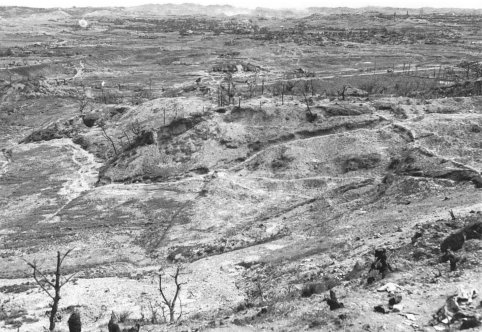
Department of Defense Photo (USMC) 124747
The difficult and shell-pocked terrain of Okinawa is seen here in a view from the crest of Sugar Loaf toward Crescent Hill and southeast beyond the Kokuba River. This photograph also illustrates the extent to which Sugar Loaf Hill dominated the Asato corridor running from Naha to Shuri and demonstrates why the Japanese defended the area so tenaciously.
The 18th of May marked the beginning of seemingly endless rains. Into the start of this soupy mess attacked Dog Company, 2/29, this time supported by more tanks which braved the minefields on both shoulders of Sugar Loaf to penetrate the no-man’s land just to the south. When the Japanese poured out of their reverse-slope holes for yet another counterattack, the waiting tanks surprised and riddled them. Dog Company earned the distinction of becoming the first rifle company to hold Sugar Loaf overnight. The Marines would not relinquish that costly ground.
But now the 29th Marines were pretty much shot up, and still Half Moon, Horseshoe, and Shuri remained to be assaulted. General Geiger adjusted the tactical boundaries slightly westward to allow the 1st Marine Division a shot at the eastern spur of Horseshoe, and he also released the 4th Marines from Corps reserve. General Shepherd deployed the fresh regiment into the battle on the 19th. The battle still raged. The 4th Marines sustained 70 casualties just in conducting the relief of lines with the 29th Marines. But with Sugar Loaf now in friendly hands, the momentum of the fight began to change. On 20 May, Lieutenant Colonel Reynolds H. Hayden’s 1/4 and Lieutenant Colonel Bruno A. Hochmuth’s 3/4 made impressive gains on either flank. By day’s end, 2/4 held much of Half Moon, while 3/4 had seized a good portion of Horseshoe. As Corporal Day had warned, most Japanese reinforcements funneled into the fight from the southwest, so 3/4 prepared for nocturnal visitors at Horseshoe. These arrived in massive numbers, up to 700 Japanese soldiers and40 sailors, and surged against 3/4 much of the night. Hochmuth had a wealth of supporting arms: six artillery battalions in direct support at the onset of the attack, and up to 15 battalions at the height of the fighting. Throughout the crisis on Horseshoe, Hochmuth maintained a direct radio link with Lieutenant Colonel Bruce T. Hemphill, commanding 4/15, one of the support artillery firing battalions. This close exchange between commanders reduced the number of short rounds which might have otherwise decimated the defenders and allowed the 15th Marines to provide uncommonly accurate fire on the Japanese. The rain of shells blew great holes in the ranks of every Japanese advance; Marine riflemen met those who survived at bayonet point. The counterattackers died to the man.
Even with Hochmuth’s victory the protracted battle of Sugar Loaf lacked a climactic finish. There would be no celebration ceremony here. Shuri Ridge loomed ahead, as did the sniper-infested ruins of Naha. Elements of the 1st Marine Division began bypassing the last of the Wana defenses to the east. The 6th Division slipped westward. Colonel Shapley’s 4th Marines crossed the Asa River, now chest-high from the heavy rainfall, on 23 May. The III Amphibious Corps stood poised on the outskirts of Okinawa’s capital city.
“Buck Rogers” rocket Marines load projectiles into the racks of a mobile launcher in preparation for laying down a barrage on Japanese positions during the Tenth Army drive to the south of Okinawa. Such barrages were very effective.
Department of Defense Photo (USMC) 181768
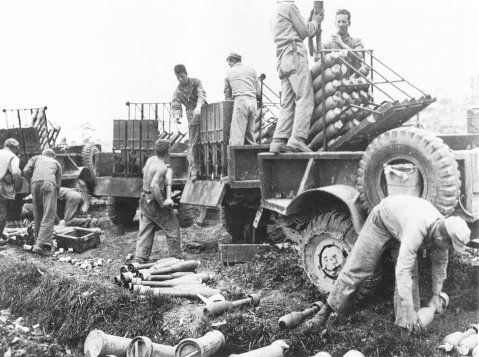
The Army divisions in XXIV Corps matched the Marines’ breakthroughs. On the east coast, the 96th Division seized Conical Hill, the Shuri Line’s opposite anchor from Sugar Loaf, after weeks of bitter fighting. The 7th Division, in relief, seized Yonabaru on 22 May. Suddenly, the Thirty-second Army faced the threat of being cut off from both flanks. This time General Ushijima listened to Colonel Yahara’s advice. Instead of fighting to the death at Shuri Castle, the army would take advantage of the awful weather and retreat southward to their final line of prepared defenses in the Kiyamu Peninsula. Ushijima executed this withdrawal masterfully. While American aviators spotted and interdicted the southbound columns, they also reported other columns moving north. General Buckner assumed the enemy was simply rotating units still defending the Shuri defenses. But these north-41bound troops were ragtag units assigned to conduct a do-or-die rear guard. At this, they were eminently successful.

Department of Defense Photo (USMC) 122390
Men of Company G, 2d Battalion, 22d Marines, found themselves fighting in an urban environment in their house-to-house attack against the Japanese in Naha.
This was the situation encountered by the 1st Marine Division in its unexpectedly easy advance to Shuri Ridge on 29 May as described in the opening paragraphs. The 5th Marines suddenly possessed the abandoned castle. While General del Valle tried to placate the indignation of the 77th Division commander at the Marines’ “intrusion” into his zone, he got another angry call from the Tenth Army. It seems that the Company A, 1/5 company commander, a South Carolinian, had raised the Stars and Bars of the Confederacy over Shuri Castle instead of the Stars and Stripes. “Every damned outpost and O.P. that could see this started telephoning me,” said del Valle, adding, “I had one hell of a hullabaloo converging on my telephone.” Del Valle agreed to erect a proper flag, but it took him two days to get one through the intermittent fire of Ushijima’s surviving rear guards. Lieutenant Colonel Richard P. Ross, commanding the 3d Battalion, 1st Marines, raised this flag in the rain on the last day of May, then took cover. Unlike Sugar Loaf, Shuri Castle could be seen from all over southern Okinawa, and every Japanese gunner within range opened up on the hated colors.
The Stars and Stripes fluttered over Shuri Castle, and the fearsome Yonabaru-Shuri-Naha defensive masterpiece had been decisively breached. But the Thirty-second Army remained as deadly a fighting force as ever. It was an army that would die hard defending the final eight miles of shell-pocked, rain-soaked southern Okinawa.
The retreating Japanese troops did not escape scot-free from their Shuri defenses. Naval spotter planes located one southbound column and called in devastating fire from a half dozen ships and every available attack aircraft. In short order several miles of the muddy road were strewn with wrecked trucks, field guns, and corpses. General del Valle congratulated the Tactical Air Force: “Thanks for prompt response this afternoon when Nips were caught on road with kimonos down.”
A Marine who had his clothing blown from his back by a Japanese mortar explosion, but is otherwise unwounded, is helped to the rear by an uninjured buddy.
Department of Defense Photo (USMC) 120280
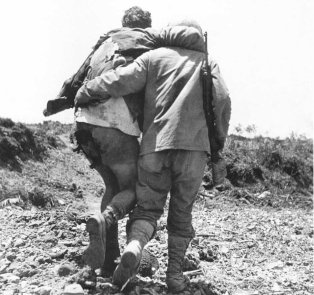
Successful interdictions, however, remained the exception. Most of Ushijima’s Thirty-second Army survived the retreat to its final positions in the Kiyamu Peninsula. The Tenth Army missed a golden opportunity to end the battle four weeks early, but the force, already slowed by heavy rains and deep mud, was simply42 too ponderous to respond with alacrity.
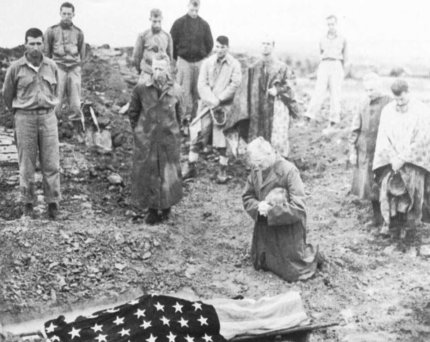
Department of Defense Photo (USMC) 122274
A bereaved father prays for his dead son: Col Francis I. Fenton, 1st Marine Division engineer, kneels at the foot of the stretcher holding the body of PFC Michael Fenton, as division staff members mourn. Col Fenton said that the other dead Marines were not as fortunate as his son, who had his father there to pray for him.
The infantry slogged southward, cussing the weather but glad to be beyond the Shuri Line. Yet every advance exacted a price. A Japanese sniper killed Lieutenant Colonel Horatio C. Woodhouse, Jr., the competent commander of 2/22, as he led his battalion towards the Kokuba Estuary. General Shepherd, grieving privately at the loss of his younger cousin, replaced him in command with the battalion exec, Lieutenant Colonel John G. Johnson.
As the IIIAC troops advanced further south, the Marines began to encounter a series of east-west ridges dominating the open farmlands in their midst. “The southern part of Okinawa,” reported Colonel Snedeker, “consists primarily of cross ridges sticking out like bones from the spine of a fish.” Meanwhile, the Army divisions of XXIV Corps warily approached two towering escarpments in their zone, Yuza Dake and Yaeju Dake. The Japanese had obviously gone to ground along these ridges and peaks and lay waiting for the American advance.
This self-propelled M-7 105mm gun was completely bogged down in the heavy rains which fell on Okinawa in the last weeks in May. It replaced the half-track-mounted 75mm gun as the regimental commander’s artillery in Operation Iceberg.
Department of Defense Photo (USMC) 123438
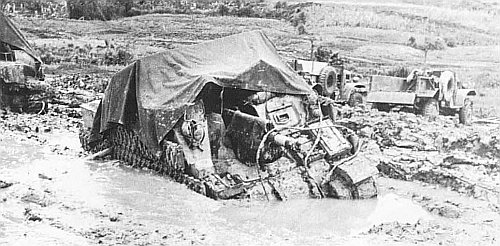
Rain and mud continued to plague the combatants. One survivor of this segment of the campaign described the battlefields as “a five-mile sea of mud.” As Private First Class Sledge recorded in the margins of his sodden New Testament, “Mud in camp on Pavuvu was a nuisance.... But mud on the battlefield is misery beyond description.” The 96th Division wearily reported the results of one day’s efforts under these conditions: “those on forward slope slid down; those on reverse slope slid back; otherwise no change.”
The Marines began to chafe at the heavy-handed controls of the Tenth Army, which seemed to stall with each encounter with a fresh Japanese outpost. General Buckner favored a massive application of firepower on every obstacle before committing troops in the open. Colonel Shapley, commanding the 4th Marines, took a different view. “I’m not too sure that sometimes when they whittle you away, 10–12 men a day, then maybe it would be better to take 100 losses a day if you could get out sooner.” Colonel Wilburt S. “Big Foot” Brown, a veteran artilleryman commanding the 11th Marines, and a legend in his own time, believed the Tenth Army relied too heavily on firepower. “We poured a tremendous amount of metal into those positions,” he said. “It seemed nothing could be living in that churning mass where the shells were falling and roaring, but when we next advanced the Japs would still be there and madder than ever.” Brown also lamented the overuse of star shells for night illumination: “I felt like we were the children of Israel in the wilderness—living under43 a pillar of fire by night and a cloud of smoke by day.”
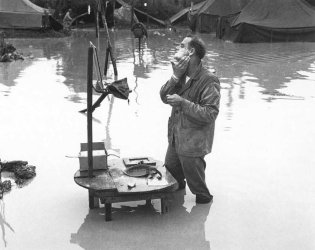
Department of Defense Photo (USMC) 123507
Cleanliness is next to godliness, figures this Marine, as he stands knee-deep in water while shaving in the midst of a totally saturated and flooded bivouac area.
Such a heavy reliance on artillery support stressed the amphibious supply system. The Tenth Army’s demand for heavy ordnance grew to 3,000 tons of ammo per day; each round had to be delivered over the beach and distributed along the front. This factor reduced the availability of other supplies, including rations. Front-line troops, especially the Marines, began to go hungry. Again partial succor came from the friendly skies. Marine pilots flying General Motors Avenger torpedo-bombers of VMTB-232 executed 80 air drops of rations during the first three days of June alone. This worked well, thanks to the intrepid pilots, and thanks to the rigging skills of the Air Delivery Section, veterans of the former Marine parachute battalions.
Offshore from the final drive south, the ships of the fleet continued to withstand waves of kamikaze attacks. Earlier, on 17 May, Admiral Turner had declared an end to the amphibious assault phase. General Buckner thereafter reported directly to Admiral Spruance. Turner departed, leaving Vice Admiral Harry W. Hill in command of the huge amphibious force still supporting the Tenth Army. On 27 May, Admiral William F. “Bull” Halsey relieved Spruance. With that, the Fifth Fleet became the Third Fleet—same ships, same crews, different designation. Spruance and Turner began planning the next amphibious assault, the long-anticipated invasion of the Japanese home islands.
General Shepherd, appreciative of the vast amphibious resources still available on call, decided to interject tactical mobility and surprise into the sluggish campaign. In order for the 6th Marine Division to reach its intermediate objective of the Naha airfield, Shepherd first had to overwhelm the Oroku Peninsula. Shepherd could do this the hard way, attacking from the base of the peninsula and scratching seaward—or he could launch a shore-to-shore amphibious assault across the estuary to catch the defenders in their flank. “The Japanese expected us to force a crossing of the Kokuba,” he said, “I wanted to surprise them.” Convincing General Geiger of the wisdom of this approach was easy; getting General Buckner’s approval took longer. Abruptly Buckner agreed, but gave the 6th Division barely 36 hours to plan and execute a division-level amphibious assault.
Okinawa’s “Plum Rains” of May and June came close to immobilizing the U.S. Tenth Army’s drive south. Heroic efforts kept the front-line troops supported logistically.
Marine Corps Historical Center
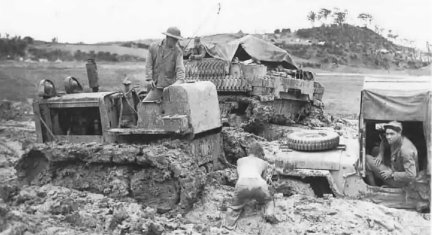
Lieutenant Colonel Krulak and his G-3 staff relished the challenge. Scouts from Major Anthony “Cold Steel” Walker’s 6th Reconnaissance Company stole across the estuary at night to gather intelligence on the Nishikoku Beaches and the Japanese defenders. The scouts confirmed the existence on the peninsula of a cobbled force of Imperial Japanese Navy units under an old adversary. Fittingly, this final opposed amphibious44 landing of the war would be launched against one of the last surviving Japanese rikusentai (Special Naval Landing Force) commanders, Rear Admiral Minoru Ota.
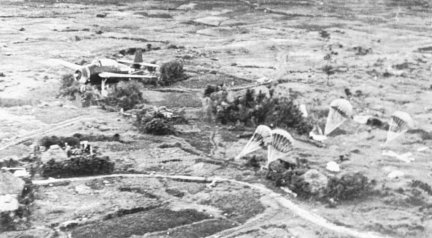
Department of Defense Photo (USMC) 126402
When the heavy rains of May arrived, deep mud caused by days of torrential downpours made air delivery the only possible means of providing forward combat units with food, ammunition, and water. As a result, Marine torpedo-bombers of VMTBs-131 and -232 were employed in supply drops by parachute. The white panels laid on the ground at the right mark the target area for the drops.
Admiral Ota was 54, a 1913 graduate of the Japanese Naval Academy, and a veteran of rikusentai service from as early as 1932 in Shanghai. Ten years later he commanded the 2d Combined Special Landing Force destined to assault Midway, but was thwarted by the disastrous naval defeat suffered by the Japanese. In November 1942, commanding the 8th Combined Special Landing Force in the Central Solomons, he defended Bairoko against the 1st Marine Raider Regiment. By 1945, however, the rikusentai had all but disappeared, and Ota commanded a ragtag outfit of several thousand coast defense and antiaircraft gunners, aviation mechanics, and construction specialists. Undismayed, Ota breathed fire into his disparate forces, equipped them with hundreds of machine cannons from wrecked aircraft, and made them sow thousands of mines.
Krulak and Shepherd knew they faced a worthy opponent, but also saw they held the advantage of surprise if they could act swiftly. The final details of planning centered on problems with the division’s previously dependable LVTs. Sixty-five days of hard campaigning ashore had taken a heavy toll of the tracks and suspension systems of these assault amphibians. Nor were repair parts available. LVTs had served in abundance on L-Day to land four divisions; now the Marines had to scrape to produce enough for the assault elements of one regiment. Worse for the planners, the first typhoon of the season was approaching, and the Navy was getting jumpy. General Shepherd remained firm in his desire to execute the assault on K-Day, 4 June. Admiral Halsey backed him up.
As soon as the parachute drops landed in the target zone, grateful Marines enthusiastically retrieved the supplies, often while under enemy fire. Some of the drops were out of reach as they landed in territory where Japanese soldiers claimed them.
Department of Defense Photo (USMC) 123168
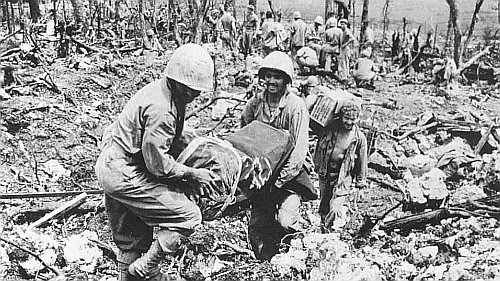
Shepherd considered Colonel Shapley “an outstanding officer of great ability and great leadership,” and chose the 4th Marines to lead the assault. Shapley divided the 600-yard Nishikoku Beach between 2/4 on the left and 1/4 on the right. Despite heavy rains, the assault went on schedule. The Oroku Peninsula erupted in flame and smoke under the pounding of hundreds of naval guns, artillery batteries, and aerial bombs. Major Anthony’s scouts seized Ono Yama island, the 4th Marines swept across the estuary, and LCMs and LCIs loaded with tanks appeared from the north, from “Loomis Harbor,” named after the IIIAC Logistics Officer, Colonel Francis B. “Loopy” Loomis, Jr., a veteran Marine aviator. The amphibious force attained complete surprise. Many of 1/4’s patched-up LVTs broke down enroute, causing uncomfortable delays, but enemy fire proved intermittent, and empty LVTs from the first waves quickly returned to transfer the stranded troops. The 4th Marines advanced rapidly. Soon it became time for Colonel Whaling’s 29th Marines to cross. By dark on K-Day the 6th Division occupied 1,200 yards of45 the Oroku Peninsula. Admiral Ota furiously redirected his sailors to the threat from the rear. Then Colonel Roberts’ 22d Marines began advancing along the original corridor.

Department of Defense Photo (USMC) 122167
It seemed to be one hill after another in the drive south. Amidst tree stumps which hardly serve as adequate cover, a bazooka team waits for an opportunity to charge into the face of Japanese fire over the crest of the hill in front of them.
The amphibious assault had been nigh letter-perfect, the typhoon came and went, and the Marines occupied the peninsula in force, capturing the airfield in two days. When the 1st Marine Division reached the southwest coast north of Itoman on 7 June, Admiral Ota’s force lost its chance of escape. General Shepherd then orchestrated a three-fold enveloping movement with his regiments and the outcome became inevitable.
Admiral Ota was no ordinary opponent, however, and the battle for Oroku was savage and lethal. Ota’s 5,000 spirited sailors fought with elan, and they were very heavily armed. No similar-sized force on Okinawa possessed so many automatic weapons or employed mines so effectively. The attacking Marines also encountered some awesome weapons at very short range—eight-inch coast defense guns redirected inland, rail-mounted eight-inch rockets (the “Screaming Mimi”), and the enormous 320mm spigot mortars which launched the terrifying “flying ashcans.” On 9 June the 4th Marines reported “character of opposition unchanged; stubborn defense of high ground by 20mm and MG fire.” Two days later the 29th Marines reported: “L Hill under attack from two sides; another tank shot on right flank; think an eight-inch gun.”
Ota could nevertheless see the end coming. On 6 June he reported to naval headquarters in Tokyo: “The troops under my command have fought gallantly, in the finest tradition of the Japanese Navy. Fierce bombardments may deform the mountains of Okinawa but cannot alter the loyal spirit of our men.” Four days later Ota transmitted his final message to General Ushijima (“Enemy tank groups are now attacking our cave headquarters; the Naval Base Force is dying gloriously....”) and committed suicide, his duty done.
Trying in vain to escape and knee deep in the water’s edge along the sea wall near the Oroku Peninsula, a Japanese soldier passes the bodies of two other soldiers.
Department of Defense Photo (USMC) 126267
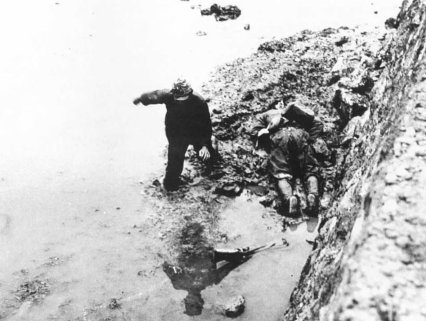
General Shepherd knew he had defeated a competent foe. He counted the costs in his after-action summary of the Oroku operation:
During the 10 days’ fighting, almost 5000 Japanese were killed and nearly 200 taken prisoner. Thirty of our tanks were disabled, many by mines. One tank was destroyed by two direct hits from an 8-inch naval gun fired at point blank range. Finally, 1,608 Marines were killed or wounded.
When the 1st Marine Division reached the coast near Itoman it represented the first time in more46 than a month that the division had access to the sea. This helped relieve the Old Breed’s extended supply lines. “As we reached the shore we were helped a great deal by amphibian tractors that had come down the coast with supplies,” said Colonel Snedeker of the 7th Marines, “Otherwise we couldn’t get supplies overland.”
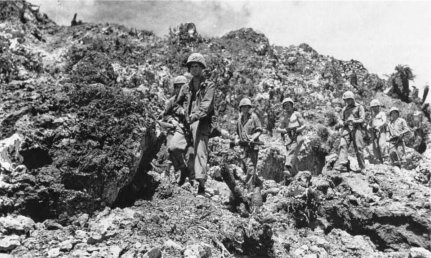
Department of Defense Photo (USMC) 125055
This Marine patrol scouts out the rugged terrain and enemy positions on the reverse slope of one of the hills in the path of the 1st Division’s southerly attack.
The more open country in the south gave General del Valle the opportunity to further refine the deployment of his tank-infantry teams. No unit in the Tenth Army surpassed the 1st Marine Division’s synchronization of these two supporting arms. Using tactical lessons painfully learned at Peleliu, the division never allowed its tanks to range beyond direct support of the accompanying infantry and artillery forward observers. As a result, the 1st Tank Battalion was the only armored unit in the battle not to lose a tank to Japanese suicide squads—even during the swirling close-quarters frays within Wana Draw. General del Valle, the consummate artilleryman, valued his attached Army 4.2-inch mortar battery. “The 4.2s were invaluable on Okinawa,” he said, “and that’s why my tanks had such good luck.” But good luck reflected a great deal of application. “We developed the tank-infantry team to a fare-thee-well in those swales—backed up by our 4.2-inch mortars.”
Colonel “Big Foot” Brown of the 11th Marines took this coordination several steps further as the campaign dragged along:
Working with LtCol “Jeb” Stuart of the 1st Tank Battalion, we developed a new method of protecting tanks and reducing vulnerability to the infantry in the assault. We’d place an artillery observer in one of the tanks with a radio to one of the 155mm howitzer battalions. We’d also use an aerial observer overhead. We used 75mm, both packs and LVT-As, which had airburst capabilities. If any Jap [suicider] showed anywhere we opened fire with the air bursts and kept a pattern of shell fragments pattering down around the tanks.
Lieutenant Colonel James C. Magee’s 2d Battalion, 1st Marines, used similar tactics in a bloody but successful day-long assault on Hill 69 west of Ozato on 10 June. Magee lost three tanks to Japanese artillery fire in the approach, but took the hill and held it throughout the inevitable counterattack that night.
Beyond Hill 69 loomed Kunishi Ridge for the 1st Marine Division, a steep, coral escarpment which totally dominated the surrounding grasslands and rice paddies. Kunishi was much higher and longer than Sugar Loaf, equally honeycombed with enemy caves and tunnels, and while it lacked the nearby equivalents of Half Moon and Horseshoe to the rear flanks, it was amply covered from behind by Mezado Ridge 500 yards further south. Remnants of the veteran 32d Infantry Regiment infested and defended Kunishi’s many hidden bunkers. These were the last of Ushijima’s organized, front-line troops, and they would render Kunishi Ridge as deadly a killing ground as the Marines would ever face.
Japanese gunners readily repulsed the first tank-infantry assaults by the 7th Marines on 11 June. Colonel Snedeker looked for another way. “I came to the realization that with the losses my battalions suffered in experienced leadership we would never be able to capture (Kunishi Ridge) in daytime. I thought a night attack might be successful.” Snedeker flew over the objective in an observation aircraft, formulating his plan. Night assaults by elements of the Tenth Army were extremely rare in this campaign—especially Snedeker’s ambitious plan of employing two battalions. General del Valle voiced his approval. At 0330 the next morning, Lieutenant Colonel John J. Gormley’s 1/7 and Lieutenant Colonel Spencer S. Berger’s 2/7 departed the combat outpost line for the dark ridge. By 0500 the lead companies of both battalions swarmed over the crest, surprising several groups of Japanese calmly cooking breakfast. Then came the fight to stay on the ridge and expand the toehold.
With daylight, Japanese gunners continued to pole-ax any relief columns of infantry, while those Marines clinging to the crest endured showers of grenades and mortar rounds. As General del Valle put it,47 “The situation was one of the tactical oddities of this peculiar warfare. We were on the ridge. The Japs were in it, on both the forward and reverse slopes.”
A Marine-manned, water-cooled, .30-caliber Browning machine gun lays down a fierce base of fire as Marine riflemen maneuver to attack the next hill to be taken in the drive to the south of Okinawa, where the enemy lay in wait.
Department of Defense Photo (USMC) 121760
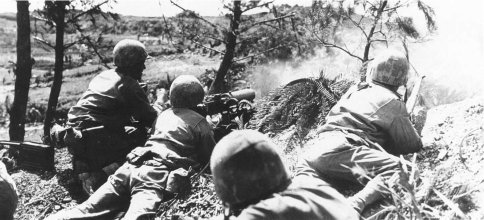
The Marines on Kunishi critically needed reinforcements and resupplies; their growing number of wounded needed evacuation. Only the Sherman medium tank had the bulk and mobility to provide relief. The next several days marked the finest achievements of the 1st Tank Battalion, even at the loss of 21 of its Shermans to enemy fire. By removing two crewmen, the tankers could stuff six replacement riflemen inside each vehicle. Personnel exchanges once atop the hill were another matter. No one could stand erect without getting shot, so all “transactions” had to take place via the escape hatch in the bottom of the tank’s hull. These scenes then became commonplace: a tank would lurch into the beleaguered Marine positions on Kunishi, remain buttoned up while the replacement troops slithered out of the escape hatch carrying ammo, rations, plasma, and water; then other Marines would crawl under, dragging their wounded comrades on ponchos and manhandle them into the small hole. For those badly wounded who lacked this flexibility, the only option was the dubious privilege of riding back down to safety while lashed to a stretcher topside behind the turret. Tank drivers frequently sought to provide maximum protection to their exposed stretcher cases by backing down the entire 800-yard gauntlet. In this painstaking fashion the tankers managed to deliver 50 fresh troops and evacuate 35 wounded men the day following the 7th Marines’ night attack.
Encouraged by these results, General del Valle ordered Colonel Mason to conduct a similar night assault on the 1st Marines’ sector of Kunishi Ridge. This mission went to 2/1, who accomplished it smartly the night of 13–14 June despite inadvertent lapses of illumination fire by forgetful supporting arms. Again the Japanese, furious at being surprised, swarmed out of their bunkers in counterattack. Losses mounted rapidly in Lieutenant Colonel Magee’s ranks. One company lost six of its seven officers that morning. Again the 1st Tank Battalion came to the rescue, delivering reinforcements and evacuating 110 casualties by dusk.
General del Valle expressed great pleasure in the success of these series of attacks. “The Japs were so damned surprised,” he remarked, adding, “They used to counterattack at night all the time, but they never felt we’d have the audacity to go and do it to them.” Colonel Yahara admitted during his interrogation that these unexpected night attacks were “particularly effective,” catching the Japanese forces “both physically and psychologically off-guard.”
By 15 June the 1st Marines had been in the division line for 12 straight days and sustained 500 casualties. The 5th Marines relieved it, including an intricate night-time relief of lines by 2/5 of 2/1 on 15–16 June. The 1st Marines, back in the relative safety of division reserve, received this mindless regimental rejoinder the next day: “When not otherwise occupied you will bury Jap dead in your area.”
The battle for Kunishi Ridge continued. On 17 June the 5th Marines assigned K/3/5 to support 2/5 on Kunishi. Private First Class Sledge approached the embattled escarpment with dread: “Its crest looked so much like Bloody Nose that my knees nearly buckled. I felt as though48 I were on Peleliu and had it all to go through again.” The fighting along the crest and its reverse slope took place at point-blank range—too close even for Sledge’s 60mm mortars. His crew then served as stretcher bearers, extremely hazardous duty. Half his company became casualties in the next 22 hours.
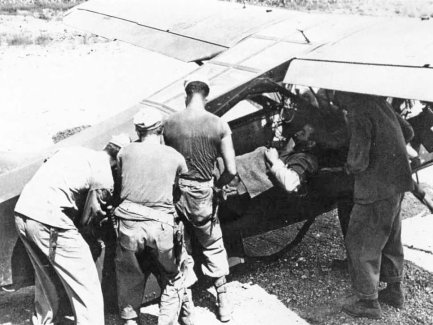
Department of Defense Photo (USMC) 123727
Navy corpsmen lift a wounded Marine into the cabin of one of the Grasshoppers of a Marine Observation Squadron on Okinawa. The plane will then fly the casualty on to one of the aid stations in the rear for further treatment.
Extracting wounded Marines from Kunishi remained a hair-raising feat. But the seriously wounded faced another half-day of evacuation by field ambulance over bad roads subject to interdictive fire. Then the aviators stepped in with a bright idea. Engineers cleared a rough landing strip suitable for the ubiquitous “Grasshopper” observation aircraft north of Itoman. Hospital corpsmen began delivering some of the casualties from the Kunishi and Hill 69 battles to this improbable airfield. There they were tenderly inserted into the waiting Piper Cubs and flown back to field hospitals in the rear, an eight-minute flight. This was the dawn of tactical air medevacs which would save so many lives in subsequent Asian wars. In 11 days, the dauntless pilots of Marine Observation Squadrons (VMO) -3 and -7 flew out 641 casualties from the Itoman strip.
The 6th Marine Division joined the southern battlefield from its forcible seizure of the Oroku Peninsula. Colonel Roberts’ 22d Marines became the fourth USMC regiment to engage in the fighting for Kunishi. The 32d Infantry Regiment died hard, but soon the combined forces of IIIAC had swept south, overlapped Mezado Ridge, and could smell the sea along the south coast. Near Ara Saki, George Company, 2/22, raised the 6th Marine Division colors on the island’s southernmost point, just as they had done in April at Hedo Misaki in the farthest north.
The long-neglected 2d Marine Division finally got a meaningful role for at least one of its major components in the closing weeks of the campaign. Colonel Clarence R. Wallace and his 8th Marines arrived from Saipan, initially to capture two outlying islands, Iheya Shima and Aguni Shima, to provide more early warning radar sites against the kamikazes. Wallace in fact commanded a sizable force, virtually a brigade, including the attached 2d Battalion, 10th Marines (Lieutenant Colonel Richard G. Weede) and the 2d Amphibian Tractor Battalion (Major Fenlon A. Durand). General Geiger assigned the 8th Marines to the 1st Marine Division, and by 18 June they had relieved the 7th Marines and were sweeping southeastward with vigor. Private First Class Sledge recalled their appearance on the battlefield: “We scrutinized the men of the 8th Marines with that hard professional stare of old salts sizing up another outfit. Everything we saw brought forth remarks of approval.”
General Buckner also took an interest in observing the first combat deployment of the 8th Marines. Months earlier he had been favorably impressed with Colonel Wallace’s outfit during an inspection visit to Saipan. Buckner went to a forward observation post on 18 June, watching the 8th Marines advance along the valley floor. Japanese gunners on the opposite ridge saw the official party and opened up. Shells struck the nearby coral outcrop, driving a lethal splinter into the general’s chest. He died in 10 minutes, one of the few senior U.S. officers to be killed in action throughout World War II.
As previously arranged, General Roy Geiger assumed command; his third star became effective immediately. The Tenth Army remained in capable hands. Geiger became the only Marine—and the only aviator of any service—to command a field army. The soldiers on Okinawa had no qualms about this. Senior Army echelons elsewhere did. Army General Joseph Stillwell received urgent orders to Okinawa. Five days later he relieved Geiger, but by then the battle was over.
The Marines also lost a good commander on the 18th when a Japanese sniper killed Colonel Harold C. Roberts, CO of the 22d Marines, who had earned a Navy Cross serving as a Navy corpsman with Marines in World War I. General Shepherd had cautioned Roberts the previous evening about his propensity of “commanding from the front.” “I told him the end is in sight,” said Shepherd, “for God’s sake don’t expose yourself unnecessarily.” Lieutenant Colonel August C. Larson took over the 22d Marines.

Department of Defense Photo (USMC) 124752
This is the last photograph taken of LtGen Simon B. Buckner, Jr., USA, right, before he was killed on 19 June, observing the 8th Marines in action on Okinawa for the first time since the regiment entered the lines in the drive to the south.
When news of Buckner’s death reached the headquarters of the Thirty-second Army in its cliff-side cave near Mabuni, the staff officers rejoiced. But General Ushijima maintained silence. He had respected Buckner’s distinguished military ancestry and was appreciative of the fact that both opposing commanders had once commanded their respective service academies, Ushijima at Zama, Buckner at West Point. Ushijima could also see his own end fast approaching. Indeed, the XXIV Corps’ 7th and 96th Divisions were now bearing down inexorably on the Japanese command post. On 21 June Generals Ushijima and Cho ordered Colonel Yahara and others to save themselves in order “to tell the army’s story to headquarters,” then conducted ritual suicide.
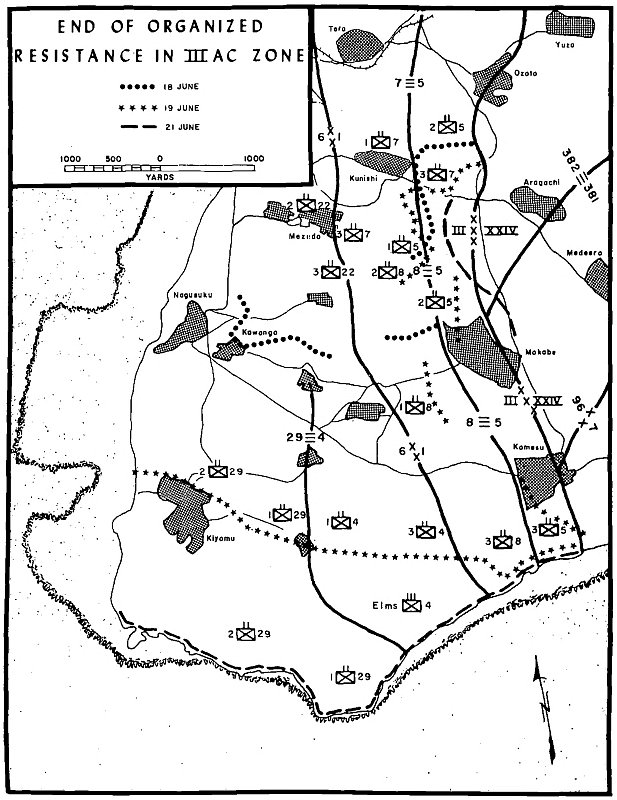
General Geiger announced the end of organized resistance on Okinawa the same day. True to form, a final kikusui attack struck the fleet that night and sharp fighting broke out on the 22d. Undeterred, Geiger broke out the 2d Marine Aircraft Wing band and ran up the American flag at Tenth Army headquarters. The long battle had finally run its course.
There was little elation among the exhausted Marines in southern Okinawa at the official proclamation of victory. The residual death throes of the Thirty-second Army kept the battlefield lethal. The last of General Ushijima’s front-line infantry may have died defending Kunishi Ridge and Yuza Dake, but the remaining hodgepodge of support troops sold their lives dearly to the last. In the closing period 17–19 June, die-hard Japanese survivors wounded Major Earl J. Cook, CO of 1/22; Major William C. Chamberlin, S-3 of the51 8th Marines; and Lieutenant Colonel E. Hunter Hurst, CO of 3/7. Even the two Marines who had survived so long in the shell crater on Sugar Loaf saw their luck run out in the final days. Private First Class Bertoli died in action. A Japanese satchel charge seriously wounded Corporal Day, requiring an urgent evacuation to the hospital ship Solace.
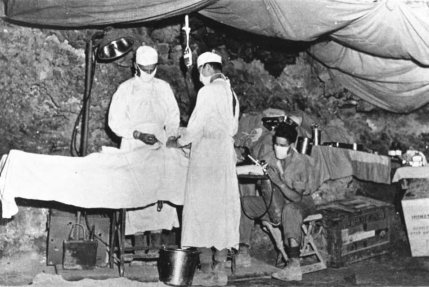
Department of Defense Photo (USMC) 123155
Okinawa’s caves behind front lines were used as temporary hospitals for emergency operations and treatment, at times when casualties could not be rushed to the rear or to a hospital ship standing in the transport area off of the landing beaches.
Okinawa proved extremely costly to all participants. More than 100,000 Japanese died defending the island, although about 7,000 uncharacteristically surrendered at the end. Native Okinawans suffered the most. Recent studies indicate as many as 150,000 died in the fighting, a figure representing one third of the island’s population. The Tenth Army sustained nearly 40,000 combat casualties, including more than 7,000 Americans killed. An additional 26,000 “non-battle” casualties occurred; combat fatigue cases accounted for most of these.
Marine Corps casualties overall—ground, air, ships’ detachments—exceeded 19,500. In addition, 560 members of the Navy Medical Corps organic to the Marine units were killed or wounded. General Shepherd described the corpsmen on Okinawa as “the finest, most courageous men that I know ... they did a magnificent job.” Three corpsmen received the Medal of Honor (see sidebar). As always, losses within the infantry outfits soared out of proportion. Colonel Shapley reported losses of 110 percent in the 4th Marines, which reflected both the addition of replacements and their high attrition after joining. Corporal Day of 2/22 experienced the death of his regimental and battalion commanders, plus the killing or wounding of two company commanders, seven platoon commanders, and every other member of his rifle squad in the battle.
The legacy of this great battle can be expressed in these categories:
• Foreshadow of Invasion of Japan. Admiral Spruance described the battle of Okinawa as “a bloody, hellish prelude to the invasion of Japan.” As protracted a nightmare as Okinawa had been, every survivor knew in his heart that the next battles in Kyushu and Honshu would be incalculably worse. In a nutshell, the plans for invading Japan specified the Kyushu landings would be executed by the surviving veterans of Iwo Jima and Luzon; the reward of the Okinawa survivors would be the landing on the main island of Honshu. Most men grew fatalistic; nobody’s luck could last through such infernos.
• Amphibious Mastery. By coincidence, the enormous and virtually flawless amphibious assault on Okinawa occurred 30 years to the month after the colossal disaster at Gallipoli in World War I. By 1945 the Americans had refined this difficult naval mission into an art form. Nimitz had every possible advantage in place for Okinawa—a proven doctrine, specialized ships and landing craft, mission-oriented weapons systems, trained shock troops, flexible logistics, unity of command. Everything clicked. The massive projection of 60,000 combat troops ashore on L-Day and the subsequent series of smaller landings on the surrounding islands represented the fruition of a doctrine earlier considered hare-brained or suicidal.
• Attrition Warfare. Disregarding the great opportunities for surprise and maneuver available in the amphibious task force, the Tenth Army conducted much of the campaign for Okinawa in an unimaginative, attrition mode which played into the strength of the Japanese defenders. An unrealistic reliance on firepower and siege tactics prolonged the fighting and increased the costs. The landings on Ie Shima and Oroku Peninsula, despite their successful executions, comprised the only division-level amphibious assaults undertaken after L-Day. Likewise, the few night attacks undertaken by Marine and Army forces achieved uncommon success, but were not encouraged. The Tenth Army squandered several opportunities for tactical innovations that could have hastened a breakthrough of the enemy defenses.
• Joint Service. The squabble between the 1st Marine Division and the 77th Division after the Marines seized Shuri Castle notwithstanding, the battle of Okinawa represented joint service cooperation at its finest. This was General Buckner’s greatest52 achievement, and General Geiger continued the sense of teamwork after Buckner’s death. Okinawa remains a model of interservice cooperation to succeeding generations of military professionals.
• First-Rate Training. The Marines who deployed to Okinawa received the benefit of the most thorough and practical advanced training of the war. Well-seasoned division and regimental commanders, anticipating Okinawa’s requirements for cave warfare and combat in built-up areas, conducted realistic training and rehearsals. The battle produced few surprises.
• Leadership. Many of those Marines who survived Okinawa went on to positions of top leadership that influenced the Corps for the next two decades or more. Two Commandants emerged—General Lemuel C. Shepherd, Jr., of the 6th Marine Division, and then-Lieutenant Colonel Leonard F. Chapman, Jr., CO of 4/11. Oliver P. Smith and Vernon E. Megee rose to four-star rank. At least 17 others achieved the rank of lieutenant general, including George C. Axtell, Jr.; Victor H. Krulak; Alan Shapley; and Edward W. Snedeker. And Corporal James L. Day recovered from his wounds and returned to Okinawa 40 years later as a major general to command all Marine Corps bases on the island.

Department of Defense Photo (USMC) 125699
1st Division Marines and 7th Infantry Division soldiers cheer exuberantly at Okinawa atop Hill 89, where the Thirty-second Army commander took his life.
During the taping of the 50th anniversary commemorative video of the battle, General “Brute” Krulak provided a fitting epitaph to the Marines who fell on Okinawa. Speaking extemporaneously on camera, he said:
The cheerfulness with which they went to their death has stayed with me forever. What is it that makes them all the same? I watched them in Korea, I watched them in Vietnam, and it’s the same. American youth is one hell of a lot better than he is usually credited.
The Washington National Records Center in Suitland, Maryland, holds primary documents of the Okinawa campaign. The III Amphibious Corps After Action Report provides the best overview, while reports of infantry battalions contain vivid day-by-day accounts. The Marine Corps Oral History Collection contains 36 interviews with Okinawa veterans, among them Lemuel C. Shepherd, Jr.; Pedro A. del Valle; Alan Shapley; Edward W. Snedeker; and Wilburt S. Brown. The Marine Corps Historical Center also holds Oliver P. Smith’s outspoken account of his Okinawa experiences as Marine Deputy Chief of Staff, Tenth Army, as well as the original interrogation report of Colonel Hiromichi Yahara, Operations Officer of the Japanese Thirty-second Army.
Among the official histories, the most useful are Benis M. Frank and Henry I. Shaw, Jr., Victory and Occupation, vol V, History of U.S. Marine Corps Operations in World War II (Washington: HistBr, G-3 Div, HQMC, 1968); Charles J. Nichols, Jr., and Henry I. Shaw, Jr., Okinawa: Victory in the Pacific (Washington: HistBr, G-3 Div, HQMC, 1955); and Roy E. Appleman, et al, Okinawa: The Last Battle (Washington: OCMH, Department of the Army, 1948). Two excellent unit histories provide detail and flavor: George McMillan, The Old Breed: A History of the 1st Marine Division in World War II and Bevan G. Cass, History of the 6th Marine Division (Washington: Infantry Journal Press, 1948). Jeter A. Isley and Philip A. Crowl provide an analytical chapter on Okinawa in U.S. Marines and Amphibious War (Princeton: Princeton University Press, 1951). Robert Sherrod provides lively coverage of Marine Air units in the campaign in his History of Marine Corps Aviation in World War II (Washington: Combat Forces Press, 1948).
More recent accounts of note include George Feifer, Tennozan: The Battle of Okinawa and the Atomic Bomb (New York: Ticknor & Fields, 1992), and Thomas M. Huber, Japan’s Battle of Okinawa, April-June 1945 (Ft. Leavenworth, Kansas: U.S. Army Command and Staff College, 1990). A particularly dramatic, first-person account is “A Hill Called Sugar Loaf” by 1stSgt Edmund H. DeMar, USMC (Ret), in Leatherneck (Jun95).
The author benefited from interviews with LtGen Victor H. Krulak, USMC (Ret), BGen Frederick P. Henderson, USMC (Ret), Mr. Benis M. Frank, and Dr. Eugene B. Sledge.
The author is also indebted to MajGen James L. Day, USMC (Ret) and LtCol Owen T. Stebbins, USMCR (Ret), for extended personal interviews—and to the entire staff of the Marine Corps Historical Center for its professional, courteous support.
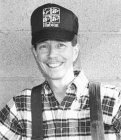
Colonel Joseph H. Alexander, USMC (Ret), served 29 years on active duty as an assault amphibian officer, including two tours in Vietnam and service as Chief of Staff, 3d Marine Division, in the Western Pacific. He is a distinguished graduate of the Naval War College and holds degrees in history from North Carolina, Jacksonville, and Georgetown.
Colonel Alexander, an independent historian in Asheville, North Carolina, wrote Closing In: Marines in the Seizure of Iwo Jima and Across the Reef: The Marine Assault on Tarawa in this series. His book, Utmost Savagery: The Three Days of Tarawa (Annapolis: Naval Institute Press, 1995), won the 1995 General Wallace M. Greene Award of the Marine Corps Historical Foundation. He is also co-author (with Lieutenant Colonel Merrill L. Bartlett) of Sea Soldiers in the Cold War (Annapolis: Naval Institute Press, 1983).
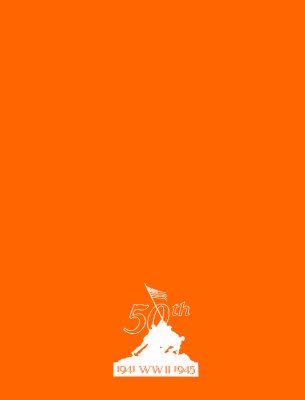
Punctuation, hyphenation, and spelling were made consistent when a predominant preference was found in this book; otherwise they were not changed.
Simple typographical errors and unbalanced quotation marks were corrected.
To make this eBook easier to read, particularly on handheld devices, some images have been made relatively larger than in the original pamphlet, and centered, rather than offset to one side or the other; and some were placed a little earlier or later than in the original. Sidebars in the original have been repositioned between chapters and identified as “[Sidebar (page nn):”, where the page reference is to the original location in the source book. In the Plain Text version, the matching closing right bracket follows the last line of the Sidebar’s text and is on a separate line to make it more noticeable. In the HTML versions, that bracket follows the colon, and each Sidebar is displayed within a box.
Page 16: “unleased” probably is a misprint for “unleashed”; “coming in take station” probably is a misprint for “coming in to take station”.
Page 31: “the forthcoming attack on of Japan” was printed that way.
Page 50 (originally on page 49): “which later what would be called” was printed that way.